|
Photo Gallery >
A stroll down Abbey Road Great Malvern
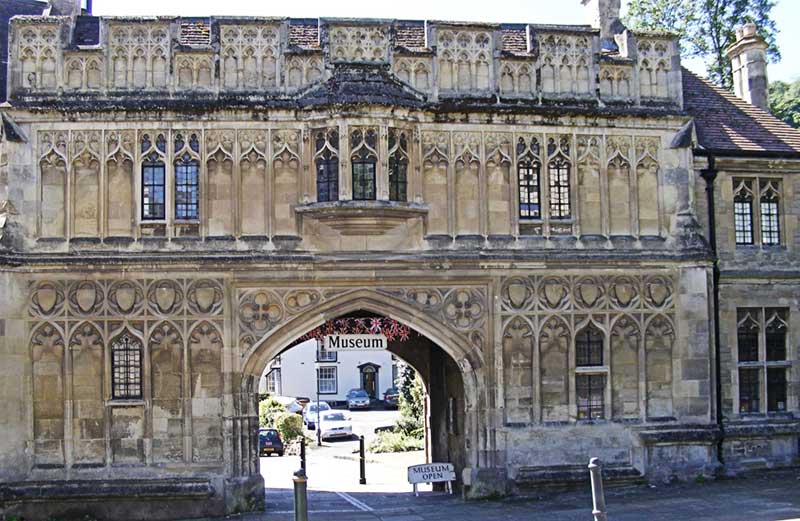
This stroll takes you on a circular walk past houses
mostly built in Victorian times of very varied and unique architectural
styles. Some notes of historical interest with particular reference to
Malvern's Water Cure establishments have been included; you will also find
notes on past schools and residents.
Choose a dry day, and start at Great Malvern Post Office at the top of Church
Street, returning to the Post Office via the Worcester Road.
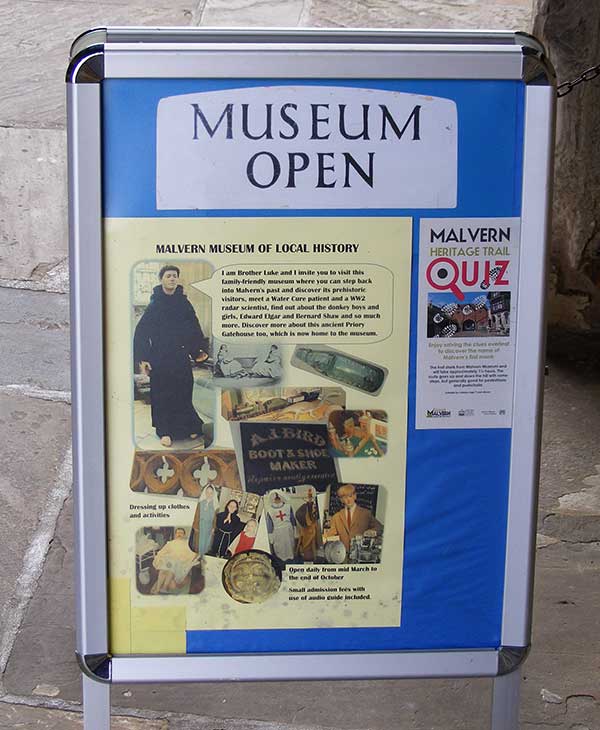 Malvern Museum Malvern Museum
Proceed south through the Abbey Gateway (see photo
above) which houses the Malvern
Museum of Local History.
The museum is usually open from Easter until the end of October, seven days
a week
The doorway can be found on the right as you pass under the archway.
Abbeyfold
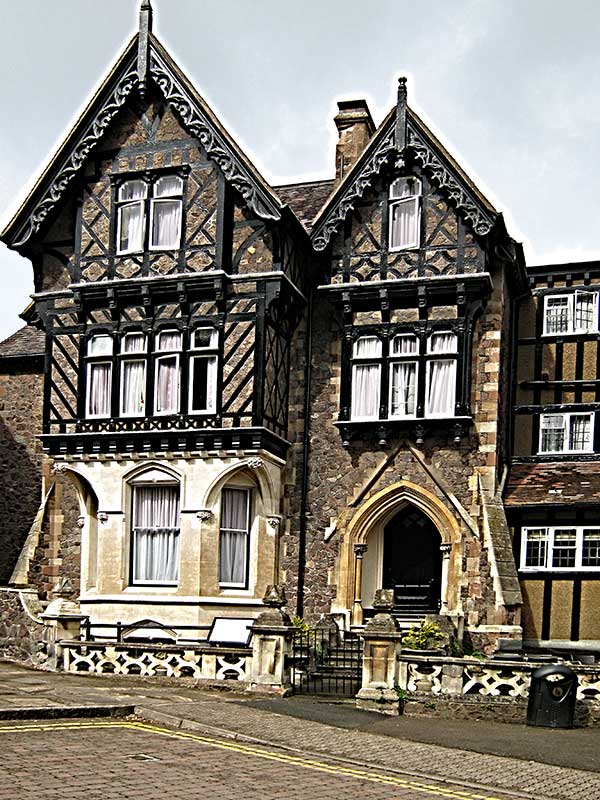
Immediately on your left you will see Abbeyfold which fills the gap
between the Abbey Gateway and the Abbey Hotel, see photo opposite.
We don't know when it was built, but a shop next to the Bluebird Tea Rooms at the top of
Church Street which has a
similar but less elaborate facade bears the date 1877.
In 1901, members of the Archer family who founded the
Abbey Hotel were in
residence.
Nowadays Abbeyfold forms part of the Abbey Hotel complex.
Abbey Hotel
Next on your left you will pass the main structure of the Abbey Hotel by
S W Daukes,
about 1848, with later additions.
Nowadays much of the stonework is hidden by
Virginia Creeper.
Adjoining, what appears to be a later extension to the hotel is in fact
Knotsford Lodge (see below) which was once a separate boarding house (ref 15). In 1851
Catherine Dickens, wife of the author
Charles Dickens, was staying at
Knotsford Lodge with her sister
Georgina Hogarth, and Dickens himself wrote
a letter from there dated 20th March 1851. In 1881 we believe Henrietta
Baden Powell was in residence at Knotsford Lodge with her daughter
Agnes Baden Powell, the mother and sister of
Robert Baden Powell who founded the Scouting movement. Agnes was
instrumental in the formation of the Girl Guides.
Built on is a modern and rather plain extension to the Abbey Hotel with
access to a large car park at the rear, probably sited on the ornamental
gardens of Knotsford Lodge.
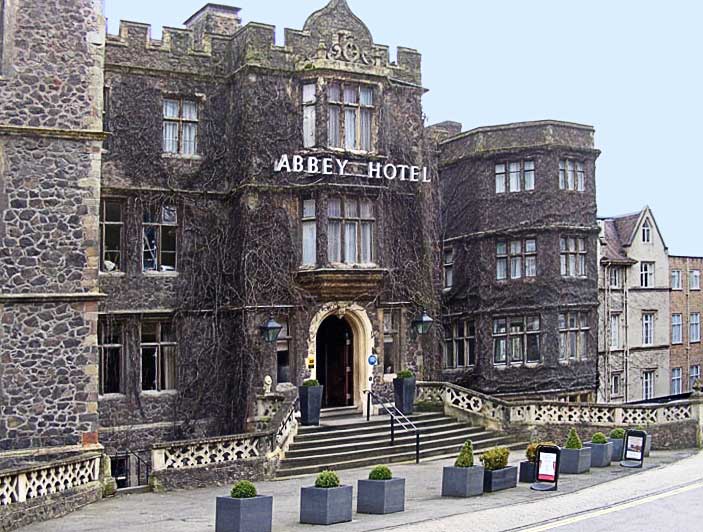
The Abbey Hotel with Knotsford Lodge just beyond
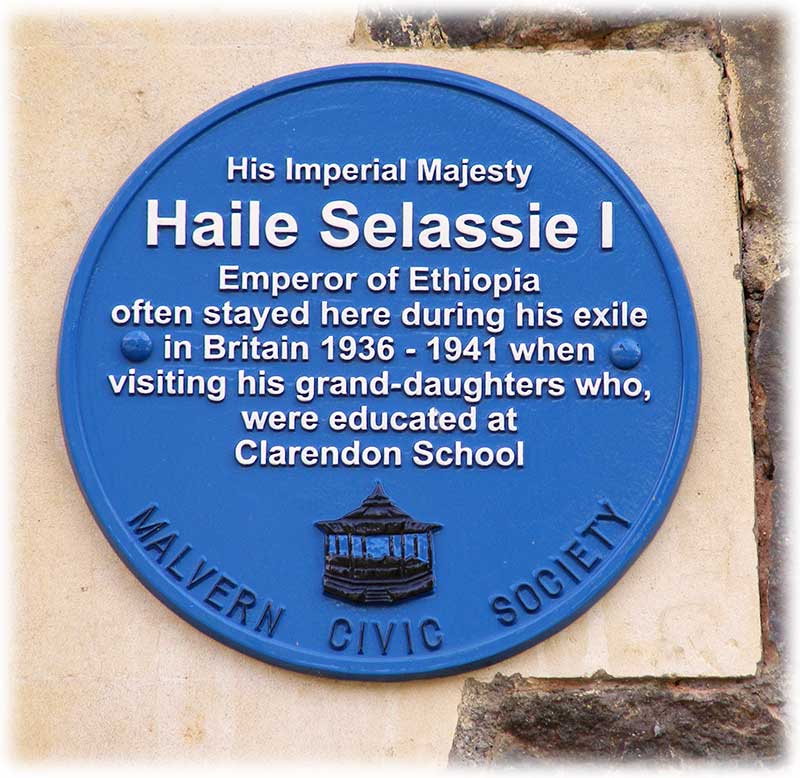 A
blue plaque on the right of the entrance reads: A
blue plaque on the right of the entrance reads:
His Imperial Majesty
Haile Selassie 1, Emperor of
Ethiopia often stayed here during his exile in Britain 1936 - 1941 when
visiting his grand-daughters who were educated at Clarendon School.
Clarendon
was a private boarding school for girls in Cowleigh Road, North Malvern.
A small gate on your right leads up steps to the Abbey
Hotel (private) gardens, sometimes used for wedding receptions.
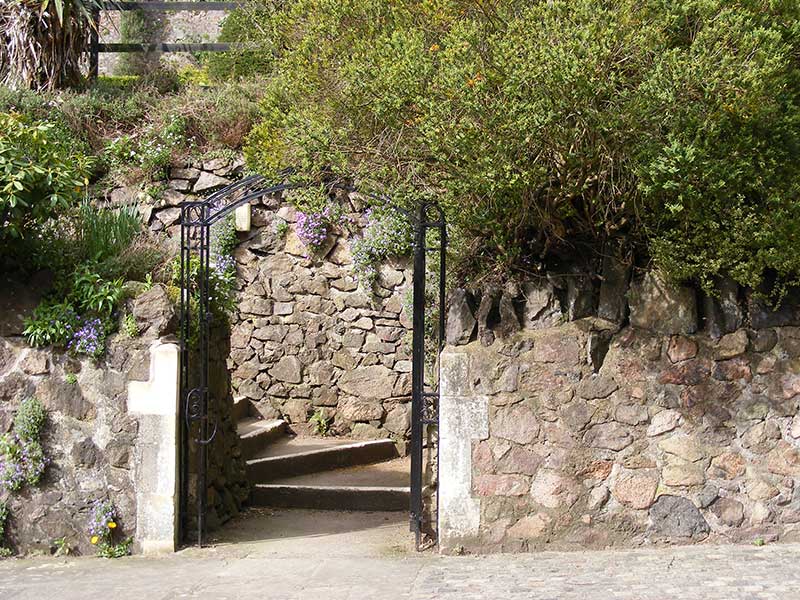
Steps to Abbey Hotel gardens
The Gate House
Beyond is a large white stuccoed Grade II listed building
now named 'The
Gate House' facing the Abbey Gateway.
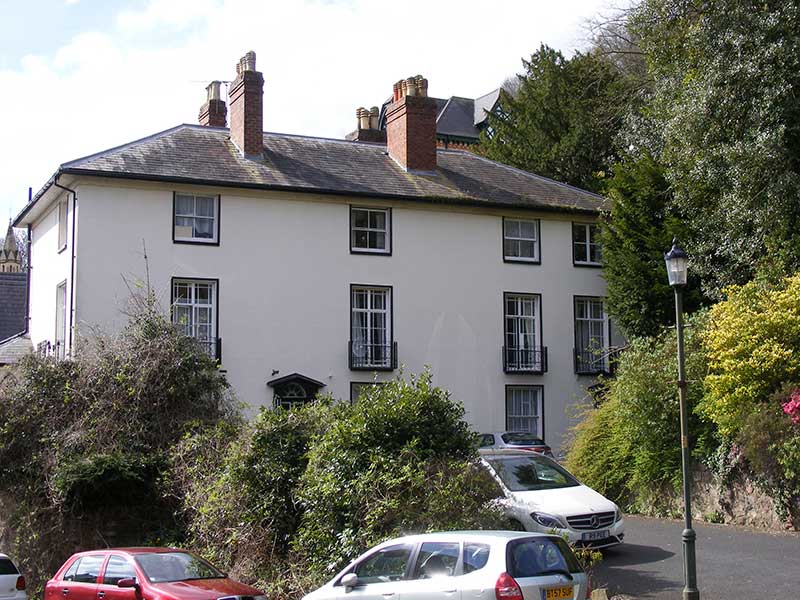
The Gate House
Description: early 19th century, three storeys, stucco on
stone, slate roof with wide eaves. Four windows, those to the first floor
are French, with marginal glazing bars and wrought-iron balconettes. Three
hung sash windows with glazing bars to the ground floor. Two moulded wooden
door cases with open pediments, carved pilasters and radiating fanlights.
Here was Abbey Terrace with
properties numbered 1, 2 and 3, described as lodging houses in the 1891 and
1901 census. We have found no trace of that name now and from street
directories it can be inferred that one by one the properties came under
common ownership and were renamed 'The Gate House' between 1911 and 1919
(ref 16).
Geoff Lewis relates (ref 14):
The Gate House, and the garages that stood where the new
town houses stand today, behind and below it, were used by the Fire
Brigade during the Second World War, as a control centre and accommodation
for the duty crews. The garages housed extra pumps and equipment that could
not be stored at the fire-station in Victoria Road. My father was in the
A.F.S. in Malvern during the war.
Knotsford Lodge
Turning to your left you will get a better view of the
middle section of the Abbey Hotel complex, which was once a separate
boarding establishment known as
Knotsford Lodge, possibly dating from 1850 or thereabouts which was named
after John Knotsford who once owned the Priory lands and whose tomb can be
found near
the altar in Great Malvern Priory.
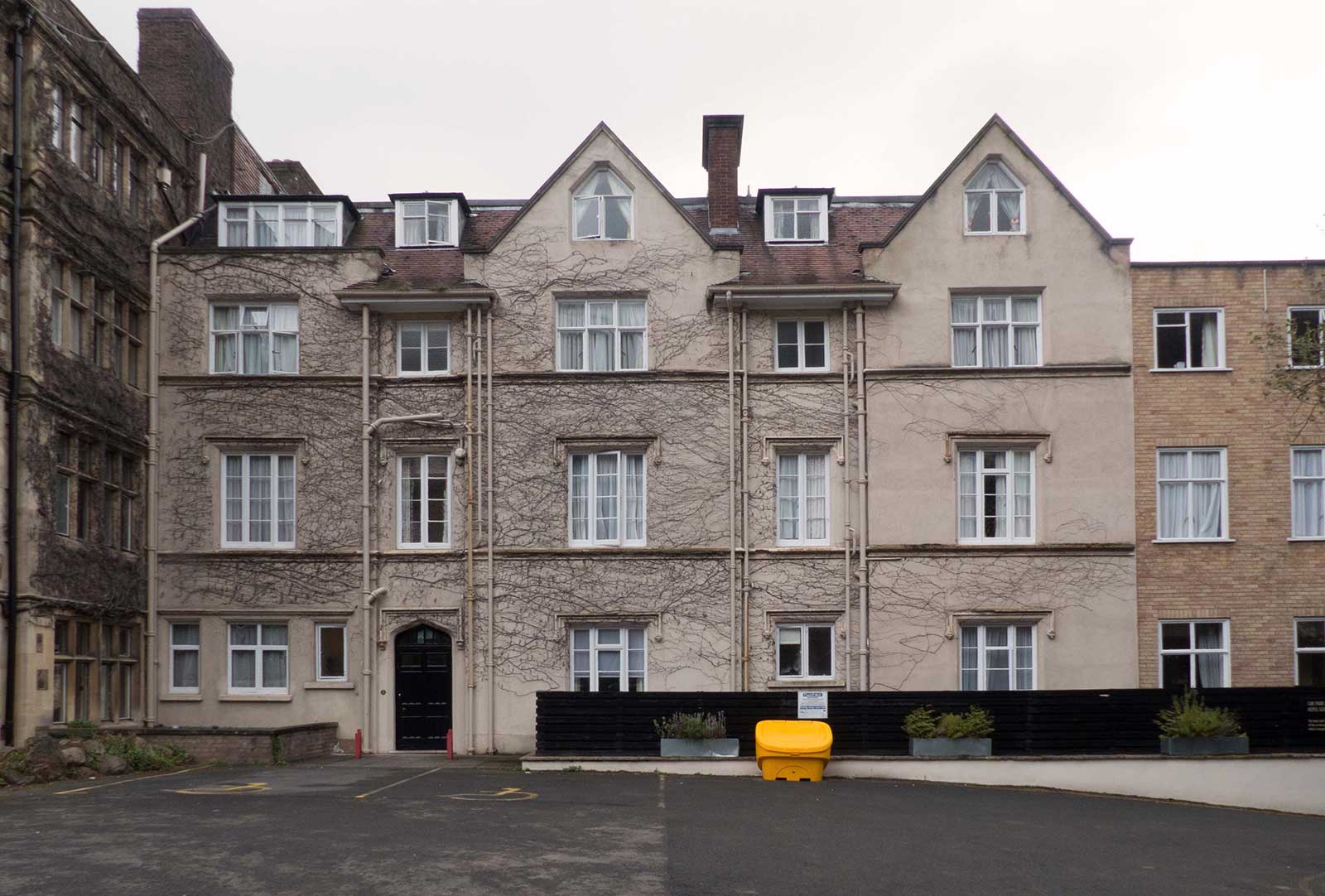
Knotsford Lodge, where Dickens stayed
Click photo above to enlarge.
Warwick Court
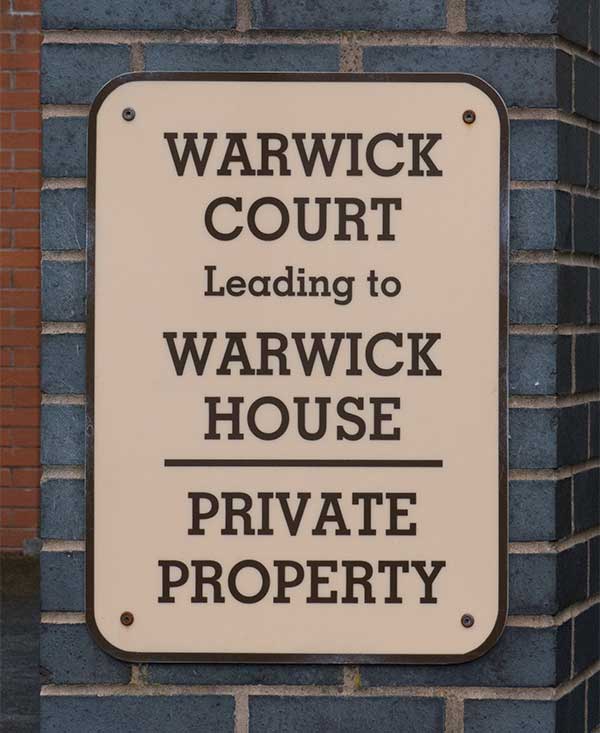 The garages below The Gate House mentioned above occupied
the site of Warwick Livery Stables. The garages below The Gate House mentioned above occupied
the site of Warwick Livery Stables.
In 1911 the proprietors
were the Woodyatt family.
A block of modern apartments named Warwick
Court stands there now.
The developers are to be congratulated that the new
buildings blend well with the surrounding Victorian houses.
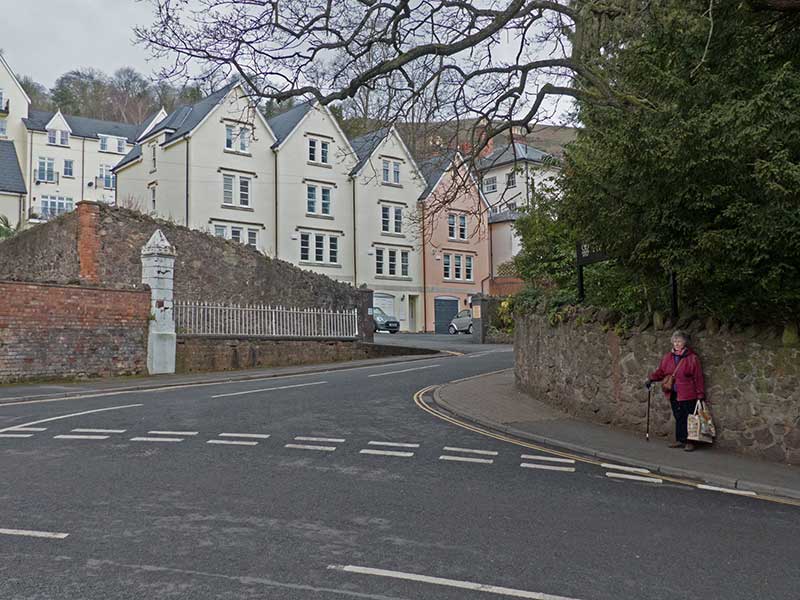
Warwick Court
Salisbury House
A little further on, where Abbey Road meets Grange Road,
you will see number six, a large white house on your right named Salisbury
House, recently renovated.
It was probably built as a hotel for those who wished to
partake of the 'water cure' and there was once a private elevated walkway which
communicated between the hotel and the water source.
In its later life it was a lodging house where actors
stayed while playing at the local theatre and known for the parties which
were hosted there. It has also been an antiques centre (ref 13).
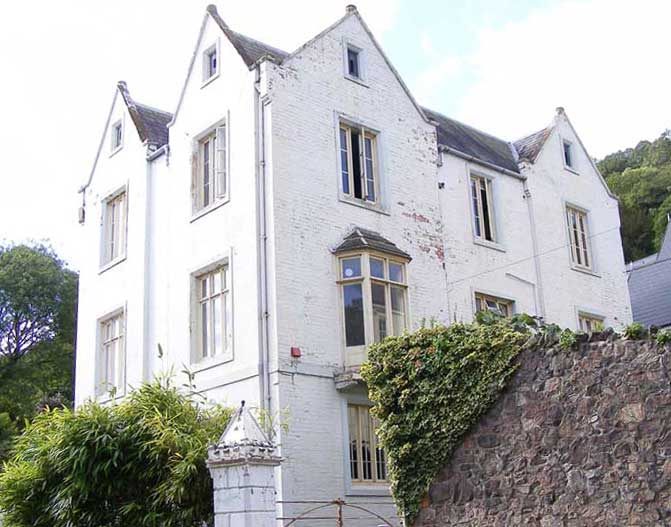
Salisbury House, undergoing renovation
The house was previously named Fonthill
which, together with Chatsworth and Tintern, obtained its water supply from the
Mason Tank above. This was a water supply put in place by the
Mason family
to serve the first houses built in Abbey Road.
In the 1870s Fonthill had been a lodging house, but the 1881 census records that
the building became Fonthill College, a small boarding school for ladies,
principal Ellen M Aldis. You can read more about Fonthill College on our
page about Malvern schools then and now.
Baptist Church
Next door, up a steep slope, largely hidden by trees, is the Baptist Church, by
respected Birmingham architect George Ingall, (1826-1900), who was a
Congregational Lay minister and designed many chapels.
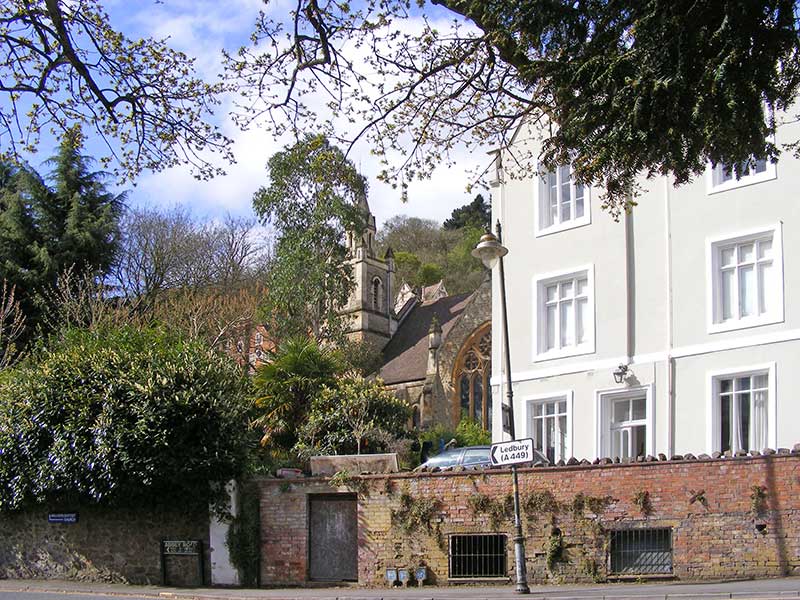
Malvern Baptist Church glimpsed from the corner of Grange
Road
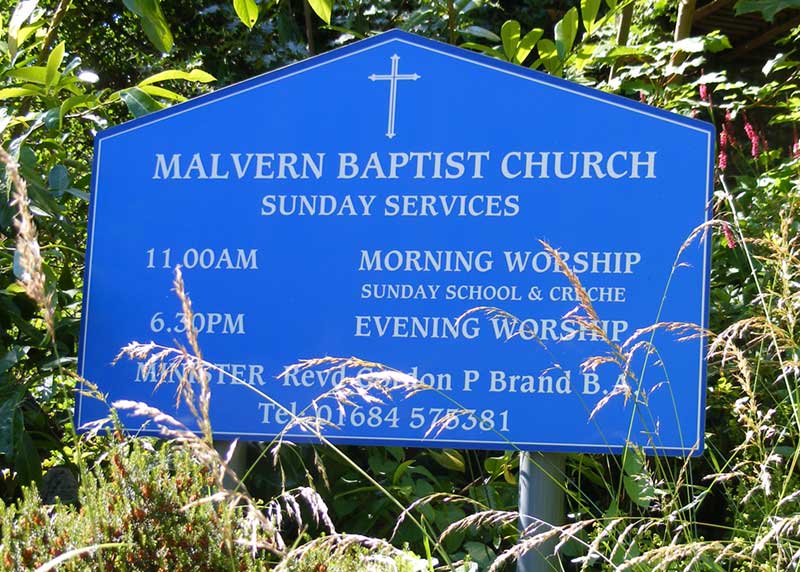 The
Baptist Church was built about 1893 on the site of the Hay Well Baths, one of Dr
Gully's Hydropathic Establishments. The Baptist minister at the time was Rev
William James Povey MA who acquired the land in 1889 and retired from the
church in 1919; you will find his grave in Great Malvern cemetery. The
Baptist Church was built about 1893 on the site of the Hay Well Baths, one of Dr
Gully's Hydropathic Establishments. The Baptist minister at the time was Rev
William James Povey MA who acquired the land in 1889 and retired from the
church in 1919; you will find his grave in Great Malvern cemetery.
Malvern
Baptist Church seating 200 is well attended and the U3A Welsh Group meets in the
cosy church hall - you will find the door to the hall on the lower east side
of the church (click to see photo
of the interior of the church).
Park View
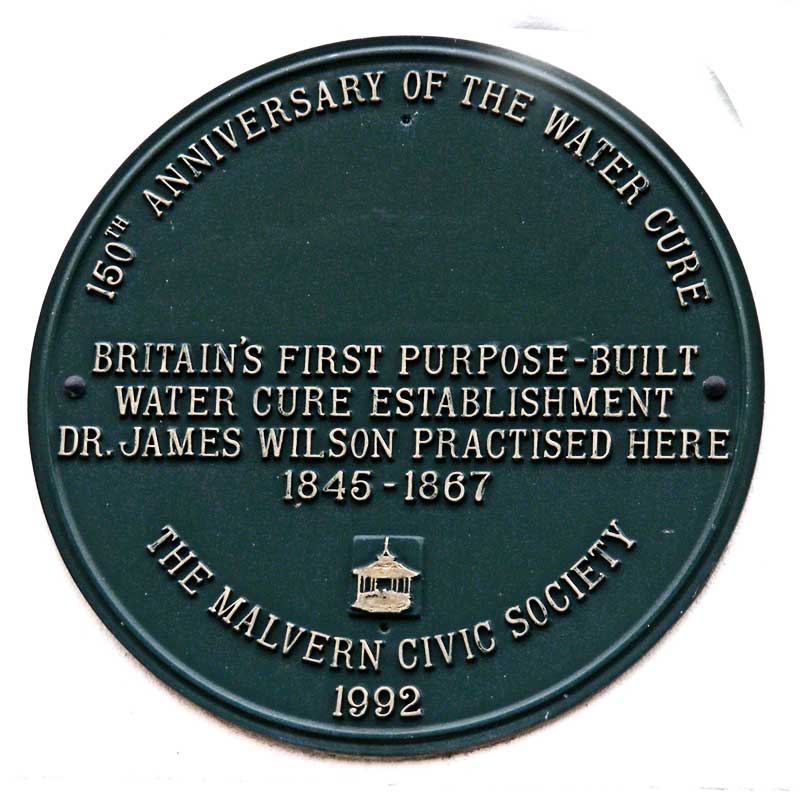 Across the road is number 33, an
imposing block of apartments overlooking Priory Park, now known as
'Park View'. The building was completed about 1848. Park View was
originally built as a Hydropathic Water Cure Establishment (see plaque opposite) for Dr James Wilson (born
1807 Holywell, Flintshire, died 1867 Ilkley, Yorkshire). When the 'Water Cure' waned
the Hydro became the County Hotel, and later it was used as a hostel for Royal Radar
Establishment apprentices. The photo below was taken from Priory Park and
shows the fine bowed facade. Across the road is number 33, an
imposing block of apartments overlooking Priory Park, now known as
'Park View'. The building was completed about 1848. Park View was
originally built as a Hydropathic Water Cure Establishment (see plaque opposite) for Dr James Wilson (born
1807 Holywell, Flintshire, died 1867 Ilkley, Yorkshire). When the 'Water Cure' waned
the Hydro became the County Hotel, and later it was used as a hostel for Royal Radar
Establishment apprentices. The photo below was taken from Priory Park and
shows the fine bowed facade.
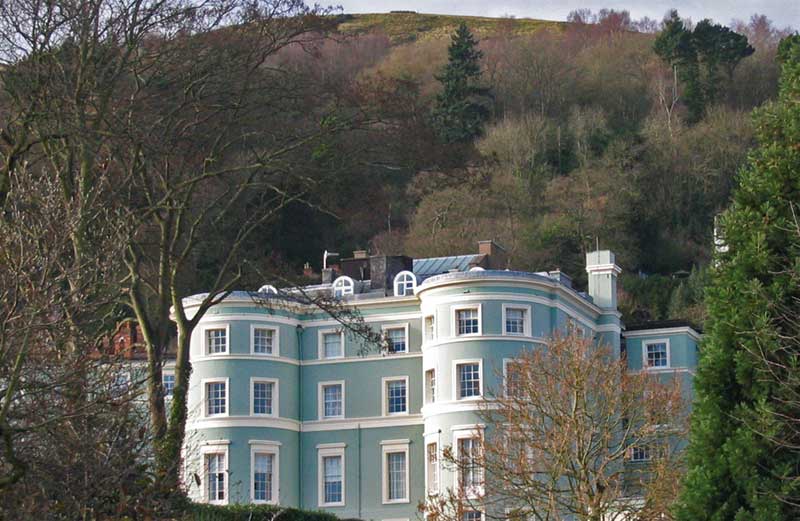
Park View
Dr Wilson lived at Grattan House, which once stood on the site of the Priory
Park Bowling Green.
The 1861 census recorded the head of household at the Hydro as Dr Walter
Johnson who may at that time have been learning his trade as Dr Wilson's
assistant. His father Dr Edward Johnson had a smaller hydropathic practice
further down Abbey Road
at Ellerslie. Read
more. In the 1871 census the head of the Establishment was
Dr Thomas Rayner, MD Edinburgh, Practising Physician, born Nuneaton
Warwickshire about 1826, who had been practising in Malvern since 1851. He
was still at the Hydropathic Establishment in 1891 when he died. It appears that Dr
Rayner had taken over the lease when Dr Wilson died in 1867.
Dr John
Campbell Fergusson leased the property when Dr Rayner died, and he and his
son were still at the Hydro in 1911. More about the history of 'Park View' can be
found in an excellent booklet published by Roger Hall-Jones (ref 4); a copy
is held in Malvern Library.
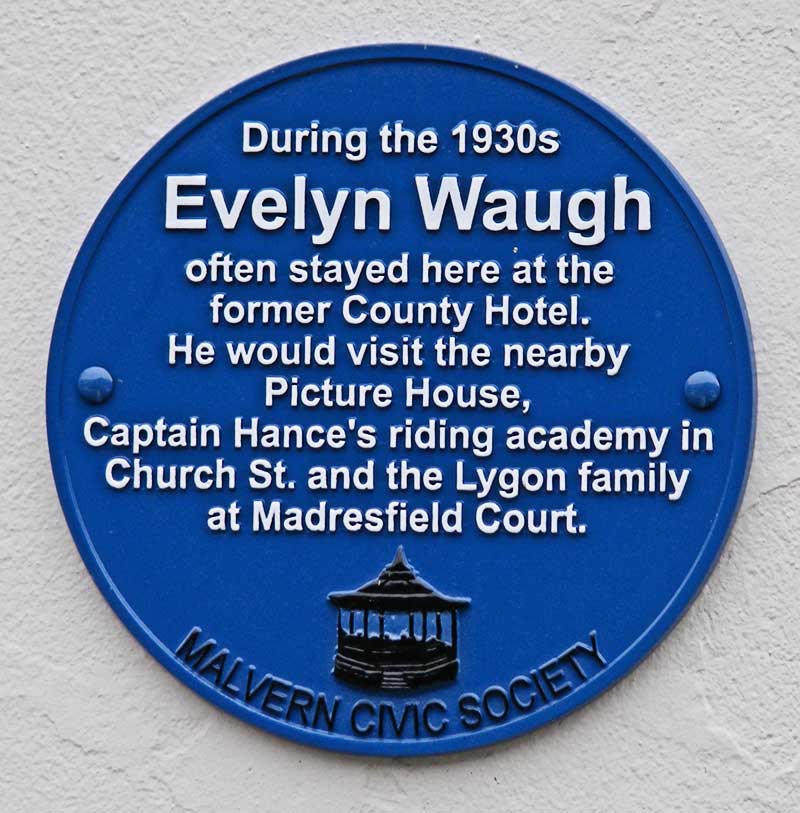 There
is a second plaque alongside the entrance to Park View. This reads, There
is a second plaque alongside the entrance to Park View. This reads,
During the 1930s Evelyn Waugh often stayed here at the former County
Hotel. He would visit the nearby Picture House, Captain Hance's riding
academy in Church St, and the Lygon family at Madresfield Court.
In addition to the County Hotel, Lady Honywood's hotel
group owned about eight other hotels including the Balmer
Lawn at Brockenhurst in the New Forest, where you can still stay.
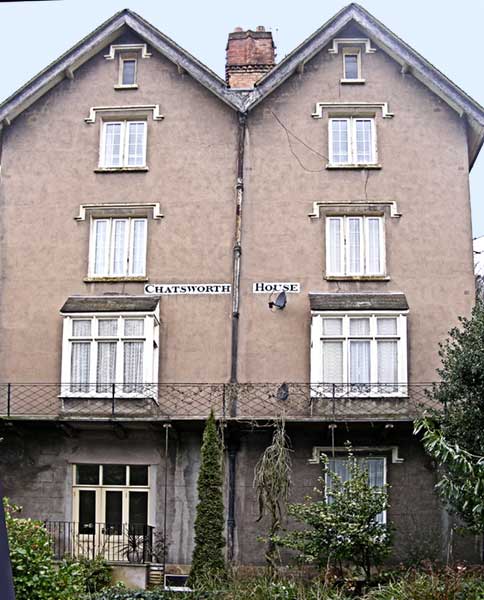
Chatsworth House
Across the road from Park View is a tall 'plain' residence named Chatsworth
House(see photo opposite).
Crown House
South of Chatsworth is Crown House, probably modern in-fill currently
owned by Worcestershire Social Services (see photo below).
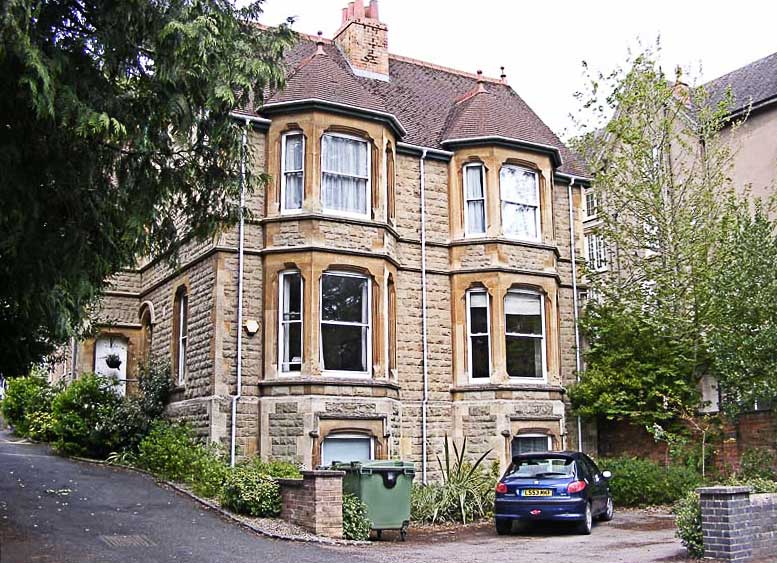
Crown House
Tintern House
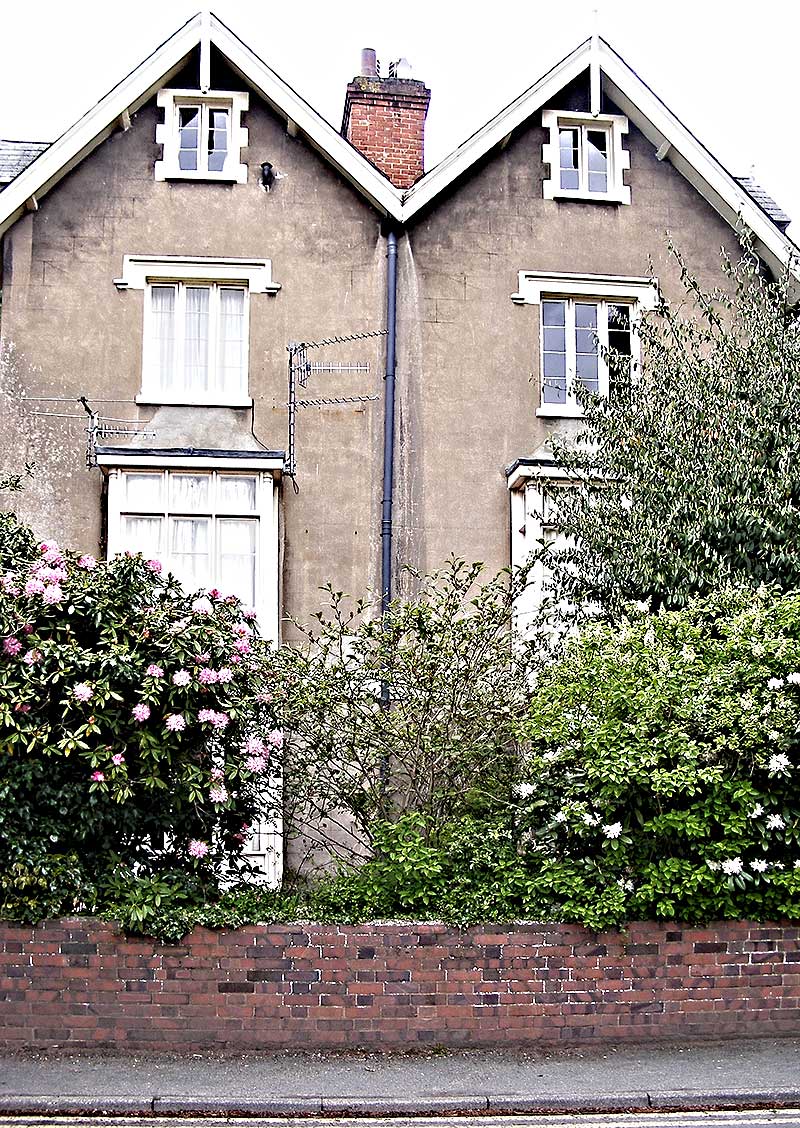
South of Crown House is Tintern House or Lodge (see photo
left) probably
dating from about 1850 and similar in style to Salisbury and Chatsworth.
Tintern House was once the home of the Woodyatt family who ran a carriage
hire and haulage business and transported materials for the Great Malvern railway
tunnel.
At the time of the 1911 census the house was named Tintern Lodge and occupied by Sarah Woodyatt,
a widow, and her daughter, a carriage motor instructress.
A coach hire business was later run from Portland Road, and there may have
once been a garage on Belle Vue Terrace.
The 1884 map of Malvern shows a building named Tintern House
at this location.
Abbotsfield
Next to Tintern House is a large house named Abbotsfield
at 14 Abbey Road. During WWII this may have been requisitioned, as in the 1950s it was in government hands,
and being considered as a possible site
for an automatic telephone exchange.
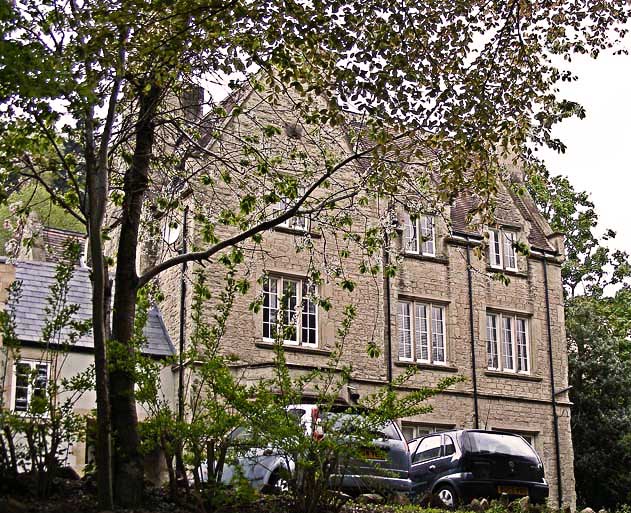
Abbotsfield
In 1956 the Malvern Electoral and Ratepayers Association
had complained to the GPO Head Office in Birmingham about the slow Manual
Exchange - concern was expressed about the long time taken to set up calls
and customers sometimes being charged for this.
The GPO's response was that they thought the service was
adequate and there was no prospect of a new exchange for a considerable time
ahead.
In the event, the new telephone exchange was built in
Albert Road South on the site of Southlea School.
In 1861 (North) Abbotsfield was the home of Dublin born 'water
cure' doctor James Loftus Marsden and his family. Dr Marsden then ran a
water cure practice at Hardwicke House and Elmsdale further along Abbey
Road (see below).
In 1871 the Marsden family visited Germany and did not appear in the census.
North
Abbotsfield was sub-let to John Doherty, born Dublin, Ireland about 1826,
Barrister at Law, and his wife Lucy.
Circa 1875, after briefly lodging at Tintern House next door, the Marsden family left Great
Malvern and retired to London (ref 11).
There must have been some development on the site of Abbotsfield as
nameplates at the entrance to the drive also now list,
-
16 Little Heath
-
18 Treetops
-
20 (no name)
-
The Coach House
These in-fill properties are not distinguishable from the road.
Croftdown Court
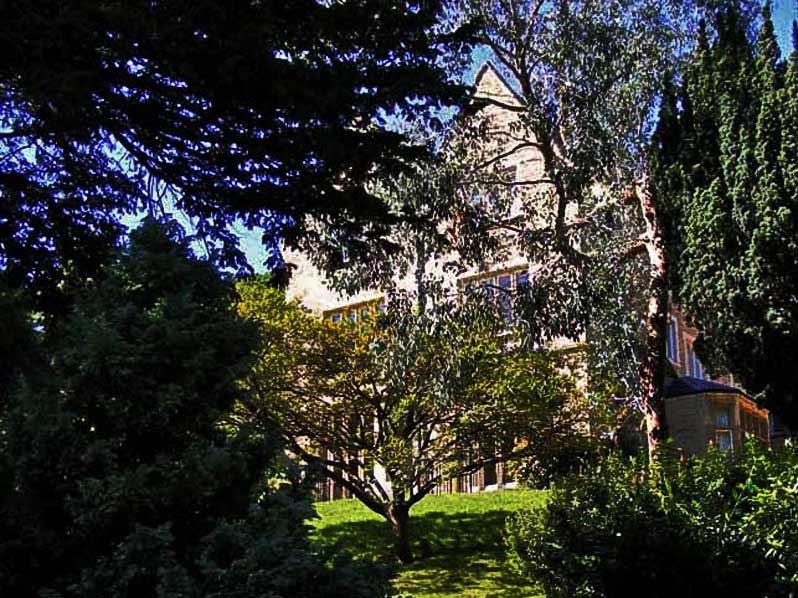
Further up the road, hidden behind trees on the right, is Croftdown
Court, now residential apartments but once the home of Croftdown Girls'
School which moved to the site about 1940.
The 1884 map of Great Malvern shows a house named South Abbotsfield once
occupied this site. In 1851 South
Abbotsfield was occupied by Mary Palmer of the
Mason family which had sold much of the
land on which Great Malvern's water cure establishments were built.
The Mason family inherited the Grange Estate, which comprised the
former monastic land south of the Priory gatehouse (Weaver and Osborne).
Malvern House
Just past Croftdown Court, the road forks, with Abbey Road bearing to the right, whilst
Priory Road forks left, looping back to the Southlea car park (opposite The
Splash).
Looking back down Abbey Road from above the fork, a good view can be had of
number 35, a large three storey red brick 'Jacobean' building with tall chimneys, which was built
about 1859 as another water cure establishment for Dr James Wilson. It
stands next door to Park View and the establishment was named Malvern
House (see photo below).
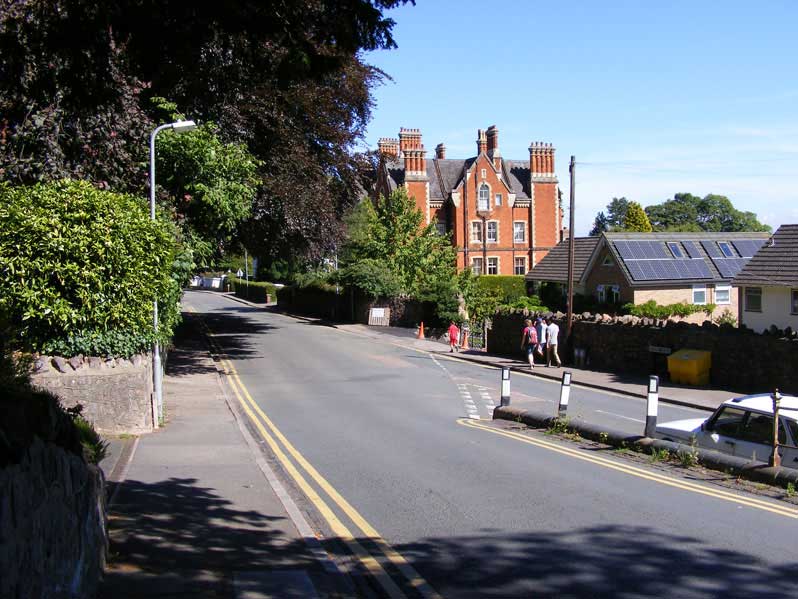
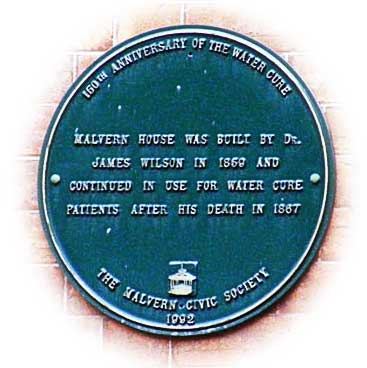
A plaque on the front of the building records: Malvern
House was built by Dr James Wilson in 1859 and continued in use for water
cure patients after his death in 1867 The census records that, after Dr Wilson's death in 1867,
between about 1871 and 1911 the
building became a lodging house run by Sarah Elizabeth Matthews (maiden surname Fleetwood, born Ledbury
1838) and her husband Joseph (born Colwall 1836).
The photo below shows the side of Malvern House and its magnificent chimneys in more
detail.
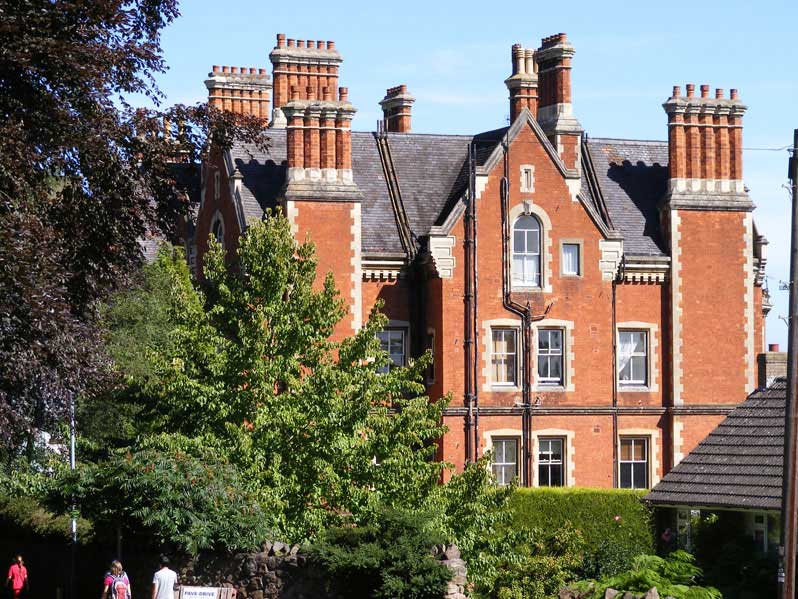
Sadly Sarah Matthew's grandson, Captain Frank Bailey Fleetwood
Perkins, Royal
Field Artillery, was killed in action, Arras, France in 1917 aged 27. He was the only son of her
daughter Harriett Louisa. In the 1911 census Frank was recorded as an Assistant
Master, College for the Higher Education of the Blind, London Road,
Whittington, Worcester.
The 1927 Ordnance Survey map of Great Malvern recorded
the building as the Malvern Hotel from where an elderly resident remembers
collecting laundry.
The Wilson Memorial
A memorial fountain to James Wilson had been erected in Abbey Road
in 1877 which later fell into disrepair and was demolished in 1948. In 2015 a new memorial
was erected at the junction of Abbey Road with Priory Road by Malvern Civic
Society.
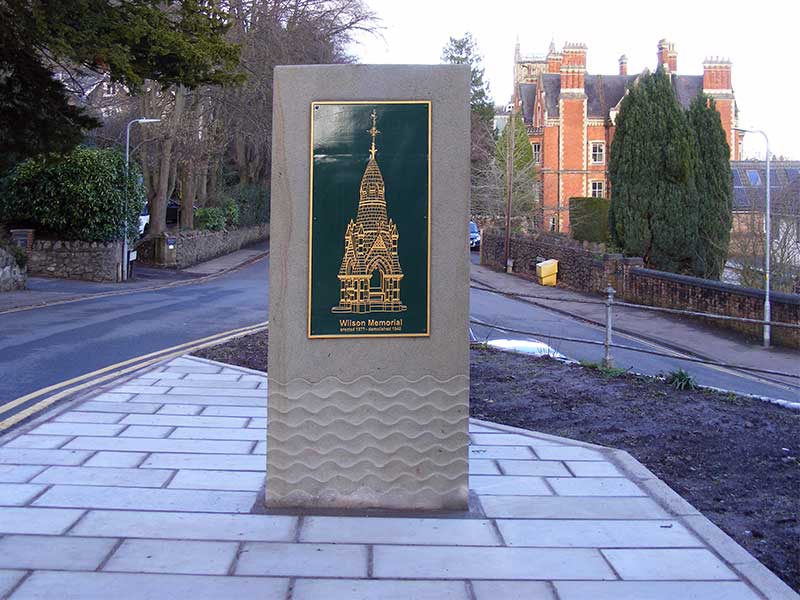
The Wilson Memorial
Malvern House, which was built for Dr James Wilson to
accommodate his water cure patients, can be seen in the background.
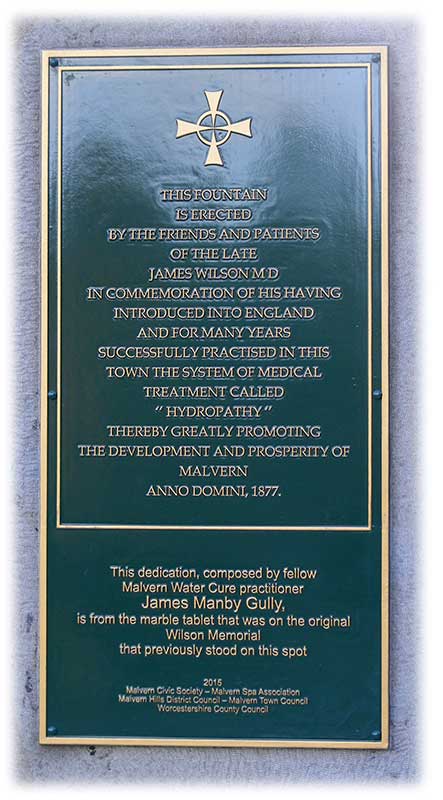 The
plaque on the north side of the memorial reads: The
plaque on the north side of the memorial reads:
This fountain is erected by the friends and patients of the late James
Wilson MD, in commemoration of his having introduced into England and for
many years successfully practised in this town the system of medical
treatment called 'Hydrotherapy' thereby greatly promoting the development
and prosperity of Malvern Anno Domini 1877.
This dedication, composed by fellow Malvern Water Cure practitioner
James Manby Gully is from the marble tablet that was on the original Wilson
Memorial that previously stood on this spot.
2015
Malvern Civic Society - Malvern Spa Association - Malvern Town Council -
Worcestershire County Council.
Shown below are more photos of old houses on the east
side of Abbey Road
overlooking the Severn Valley. Some are examples of mock Gothic style
contrasting with the simple brick built structures of today.
In her book 'The Silhouette of Malvern' Catherine Moody
wrote in 1953 that:
a walk along Priory, Abbey or Avenue Roads is like
visiting a museum of architectural features from famous monuments of
medieval architecture from England and the Continent.
Wellington House
Number 43 is a rather plain looking house with three gables but many
interesting tall chimneys.
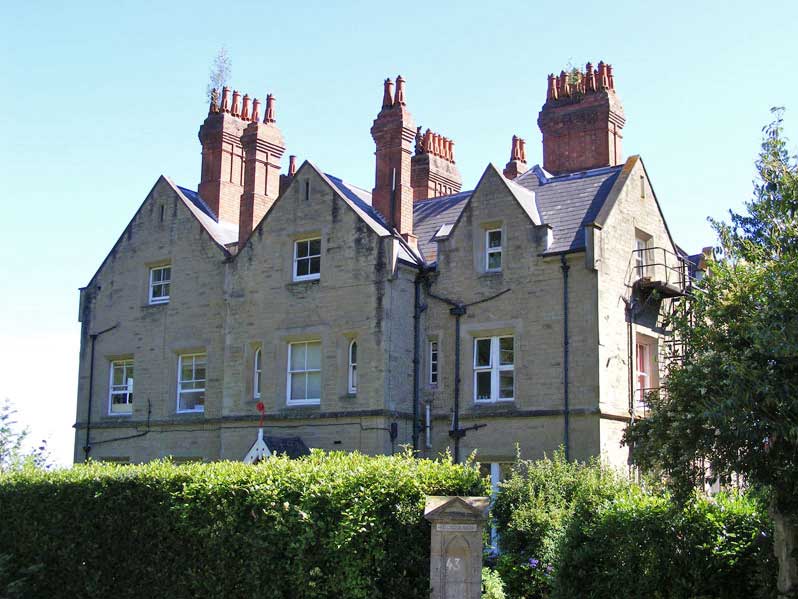
Wellington House
The 1871 and 1881 census record that Wellington House was
used for a time as a school for young ladies run by Elizabeth Jay and her
business partner Joyce Chapman who was born Croydon in 1823. Prior to this,
in 1861, they were running Oakfields Academy for girls at Droitwich Road,
Claines.
Southfield Lodge
Number 45 is a magnificent gentleman's residence built about 1851.
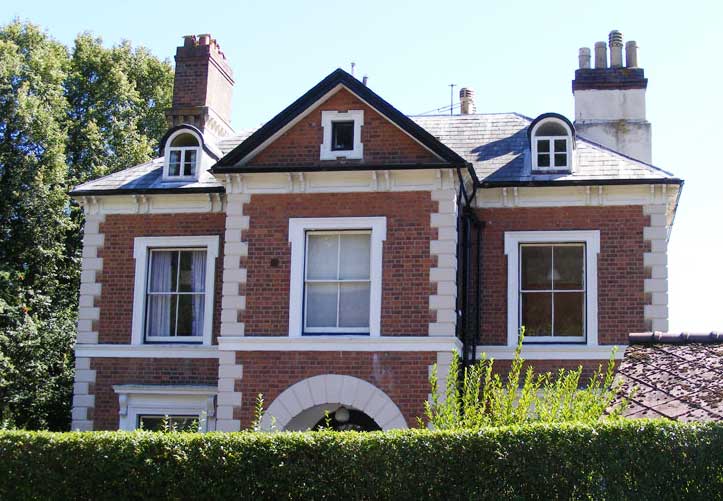
Southfield Lodge
In 2016 the house was being modernised.
South Bank
Number 47 is a remarkable mock Gothic house, now divided
to make two homes; the other half is now named Glendaruel numbered 47a.
The 1901 and 1911 census record that South
Bank was then occupied by Robert Arthur Hollins who gave his occupation as a
retired merino
spinner.
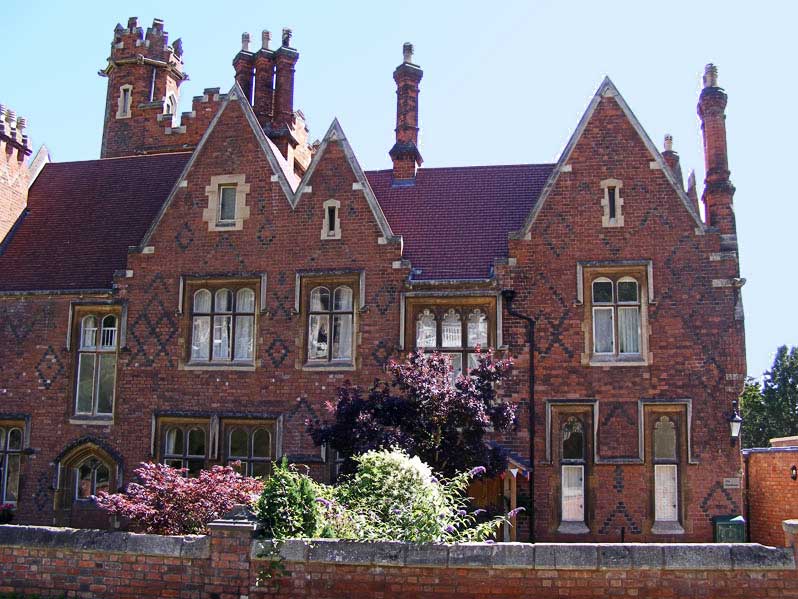
South Bank and Glendaruel
More about Robert Arthur Hollins
Robert Arthur Hollins was born in Stockport in
Cheshire1838 into a family of Cotton Spinners. His grandfather Henry Hollins
with four partners had leased land at
Pleasley on the
border between Derbyshire and Nottinghamshire and founded a cotton spinning
business which was continued by his son William under the name
William Hollins and Co.
Robert was the son of William Hollins' brother Edward and
we think Robert was employed by his uncle at the firm's Pleasley Vale Works.
The London Gazette recorded on 4th December 1883:
Notice is hereby given that the partnership heretofore
subsisting between us the undersigned William Hollins, William Byerley
Paget, Joseph Paget, Robert Arthur Hollins,and Henry Ernest Hollins, lately
carrying on business as Cotton, Merino and Silk Spinners at Pleasley in the
county of Derby, at Fletchergate in the town of Nottingham, and at Lenton
and Radford, in the extended borough of Nottingham, under the style or firm
of William Hollins and Co, has been dissolved by mutual consent, as from the
28th day of December 1882. Dated this 29th day of November 1883.
This event probably marked Robert's retirement to Great
Malvern and in 1885 he married Edith Blanche Anderson, the daughter of a
farmer. The couple had one son, William Arthur Hollins, born at Malvern in
1893, who became a
market gardener.
Merino Spinner Robert Arthur Hollins died at South Bank,
Great Malvern in 1919 and was buried in Great Malvern cemetery. His widow Edith continue to live at South Bank until
her death in 1951. The London Gazette recorded on 1st April 1920 that she
had been awarded the OBE:
Mrs Edith Blanche Hollins, Superintendant, Work Depot for
Soldiers' Comforts, Malvern.
You can find our more about Edith Hollins OBE at Malvern
Museum.
Robert's brother Henry Ernest Hollins continued as a
manager of William Hollins and Co until 1890 when the company was dissolved.
That or an associated Hollins company developed a new fabric named
Viyella, a mix of Merino
Wool and Cotton.
The family seems to have had a finger in a number of
pies. Robert's younger brother Francis Hollins (1843 - 1924), later created Sir
Frank Hollins Baronet, was a partner in Hollins Brothers and Co which merged
with Horrocks in 1885, and Crewdson in 1887. Francis became the manager of
the joint company
Horrockses, Crewdson and Co, Cotton Spinners and Manufacturers.
Walmer Lodge
The Walmer Lodge, 49 Abbey Road, has, in the past, been run as a lodging house, hotel and
restaurant. Current status unknown. Staying there in 1911 was clergyman
Thomas Fletcher Royds, a curate to the vicar of Great Malvern. Thomas was the
first cousin twice removed of Freemason Alfred Hudson Royds who is mentioned below. In 1912
Thomas married Bertha Grace Milward at Great Malvern Priory. She was
the daughter of Robert Milward, solicitor, Notary Public, JP and Alderman of
the county of Worcestershire.
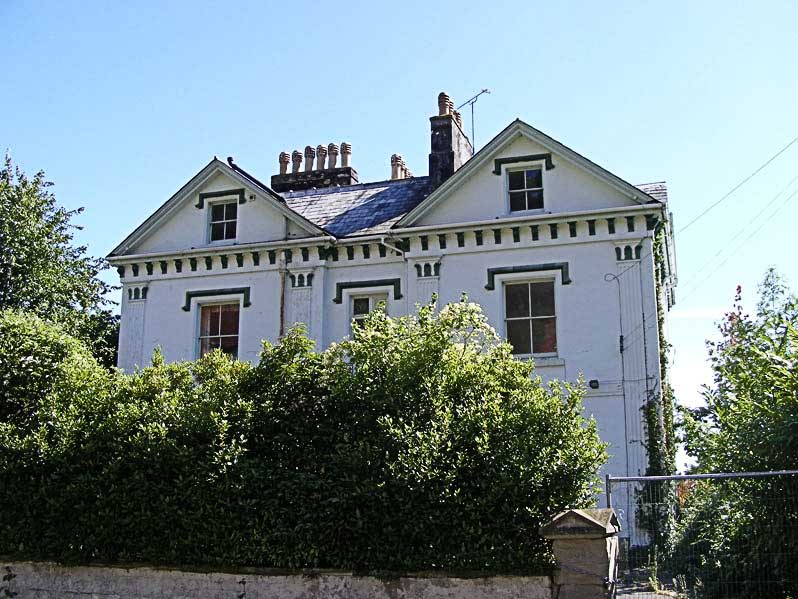
Walmer Lodge
Sutherland
Number 51, Sutherland (no photo) is similar in style to the Walmer Lodge but has a
colonnaded porch.
Elmsdale
Number 53, Elmsdale, and Hardwicke House, which stood next door, were
built as water cure establishments for Dr
James Loftus Marsden (read more about below).
Elmsdale was built about 1853 possibly to a design by
architect Samuel
Sanders Teulon. It has stepped gables with a two storey balustraded
porch, and a north tower sporting a broached spire.
On either side of the porch
is the letter 'M' and over is a shield with a unicorn. A feature
on the tower is scrollwork looking like 'three swords' set into the stonework.
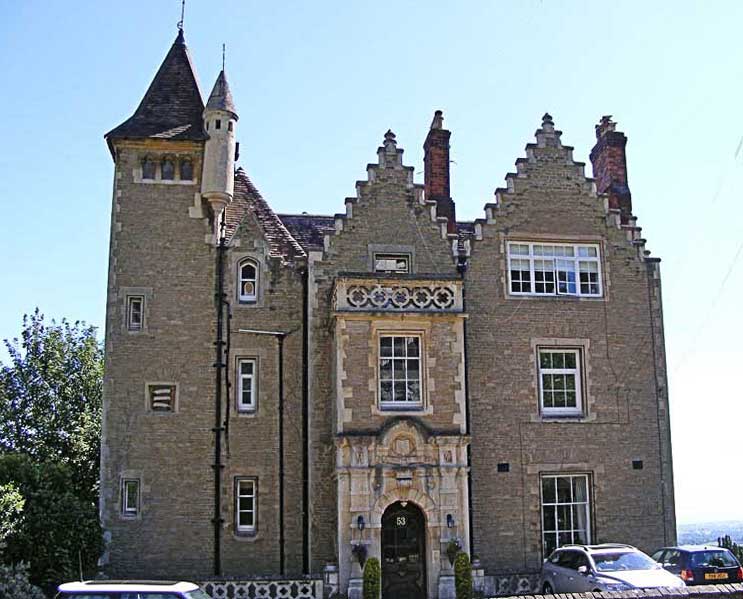
Elmsdale
In 1857 Miss
Caroline Cooper started a Ladies' School at Elsmdale, moving to
Malvernbury two doors down by 1871.
The 1871 census and Littlebury's Directory and Gazeteer
of 1873 record that Elmsdale then became a school for young ladies known as
'The Ladies College' run by Mrs Rachel Rose Gilbert. This was listed in the
publication 'Schools for Girls and Colleges for Women' published by Charles
Eyre Pascoe in 1879.
Rose the daughter of a teacher and methodist minister had
married schoolmaster George Mowbray Gilbert who was born Gosport. In 1851 he
was running the Goodenough School at Ealing, in 1861 they were in Worcester,
and in 1871 at Elmsdale in Great Malvern, when she is described as a
schoolmistress and he as a fund holder. George died at Elmsdale in 1877, and
Rose died there on 5th April 1879. At the time of the 1881 census Elmsdale
was uninhabited and presumably advertised to let.
Rose's son
Walter Raleigh Gilbert was a gifted cricketer and cousin of WG Grace,
who emigrated to Canada. Sadly Walter's son 2nd Lt Archibald Holmes Gilbert,
22 Squadron, Royal Flying Corps died in Belgium on 21st September 1917. He
had previously served with the Canadian Infantry.
Later Emsdale house became a preparatory boarding school
for boys, run by Fanny Elizabeth Ridley; that school was in existence until
at least 1908.
Hardwicke House
The original Hardwicke House, was built about 1851 as a
water cure establishment for Doctor James Loftus Marsden (1815-1891) who
about 1861 lived at North Abbotsfield across the road.
Dr Marsden retired to London about
1875, but Hardwicke and Elmsdale remained in Marsden family hands until about 1905.
The 1871 census recorded Hardwicke House as a boarding house kept
by Elijah Finn and his wife Mary, who either were employed by Dr Marsden or
leased the property.
Earlier, in 1861, Elijah, born Kent about
1827, had been recorded as a servant at Great Malvern Vicarage. The
vicar of Great Malvern Priory was then the Revd George Fisk who had led the
funeral service of Dr James Wilson of the Hydropathic Establishment on 16th
January 1867.
Dr Marsden's first wife Lucy Rashdall died in childbirth in 1847
and is buried in the Priory churchyard. She was the aunt of Oxford
theologian Hastings
Rashdall and sister of Revd John Rashdall who was vicar at the Priory
between about 1850 and 1856.
(Two of the Marsden daughters died in suspicious
circumstances in 1853 - the children's deaths are explored in a new book 'The Water
Doctor's Daughters' by Australian author Pauline
Conolly who gave a talk to the Malvern Family History Society. The book
was published by Robert Hale in 2013 and is available from The Malvern Book
Co-op in St Ann's Road and Malvern library. It
provides an excellent overview of the development of the water cure in
Great Malvern and the life of James Loftus Marsden.)
Sadly in the 1960s, Hardwicke House fell into disrepair and was
demolished about 1965. It was replaced by a modern block of flat roofed
apartments. These have good views but are in stark contrast to the Victorian houses in
Abbey Road.
The photo below,
taken from College Road, shows the east side of the c1965 Hardwicke House.
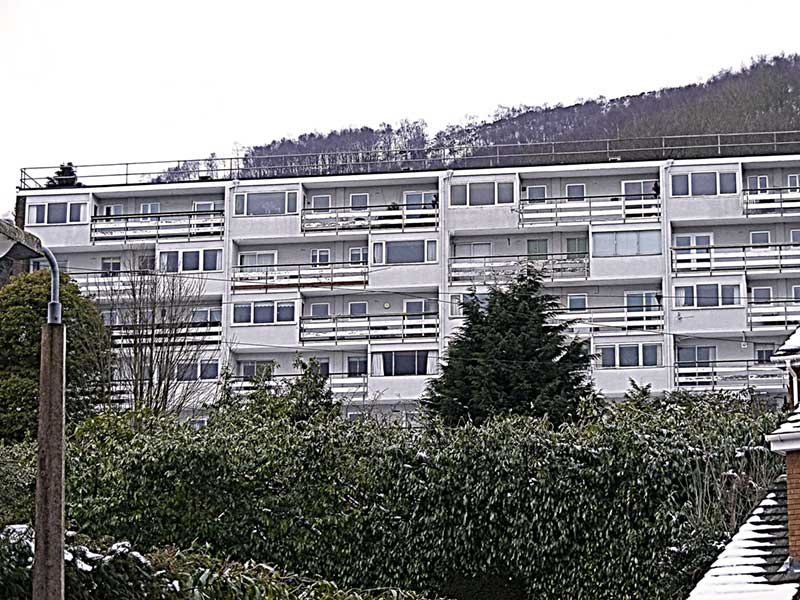
Hardwicke House
Chesfield
Number 59, Chesfield, lies below Abbey
Road between Hardwick House and Malvernbury. Two storey plus lower ground
floor, detached house. Coursed stone elevations, dressed stone detailing,
brick chimneys, tiled roof, three gables at rear. Chesfield was probably
built about 1886 as it is not marked on an 1884 map of Abbey Road.
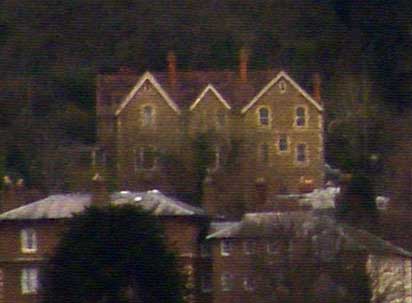 You
can't see much of Chesfield from Abbey Road. This long distance shot of the
east face of Chesfield was taken from Guarlford (see photo opposite). You
can't see much of Chesfield from Abbey Road. This long distance shot of the
east face of Chesfield was taken from Guarlford (see photo opposite).
Kelly's 1892 trade directory lists Thomas Gatward in
residence. Later, in 1911, he was a hotel proprietor at the Montrose Hotel in
Graham Road, so possibly he used the house as a small private hotel.
Kelly's listed Charles Langford Oliver (born at Brighton
in 1835) in residence at Chesfield in 1900. He was a retired Indian army officer, who
died at the seaside town of Christchurch in Hampshire on 21st June 1908
leaving a widow, his second wife, Louisa Elinor Harriet nee Moysey.
The 1911 census recorded retired schoolmaster Francis
Alfred Hooper aged 74 years in residence at Chesfield with his wife Emily, a cook,
parlour maid and house maid. The census form records the house having 13
rooms (excluding scullery, landing, lobby, closet and bathroom). Despite
having such a large house, they had no children.
Between 1932 and 1940 Kelly's records Claude Kingsley
Knowles in residence. Claude was the son of an architect, and recorded as a
'student in insurance' in the 1911 census; during WWI he had served as a 2nd
Lt in the Tank Corps. His father William Henry Knowles, FRA, FRIBA,
architect and archeologist, born 1857, died at Chesfield on 18th January
1943, and the house was offered for sale by Lear and Sons in 1949.
Architect, William Henry Knowles came to Malvern late in
life; he practised mostly in Newcastle upon Tyne and surrounds being
responsible, for example, for the main building and gateway of the School of
Art and other departments of King's College Newcastle. In later life he was
in charge of excavations of the Roman baths at Bath and researched the Saxon
church at Deerhurst. He was architect for the stonework of the
Miners Memorial which was
erected in memory of the men who died in the
Woodhorn Colliery accident of 1916.
Number 61. The present Malvernbury, by A Hill
Voysey, 1907, is set below Abbey Road halfway between Hardwicke House and
the junction with College Road. The photo below was taken in 2015 when the
building was being modernised - all that could be seen when we took this
photo was the roof and scaffolding.
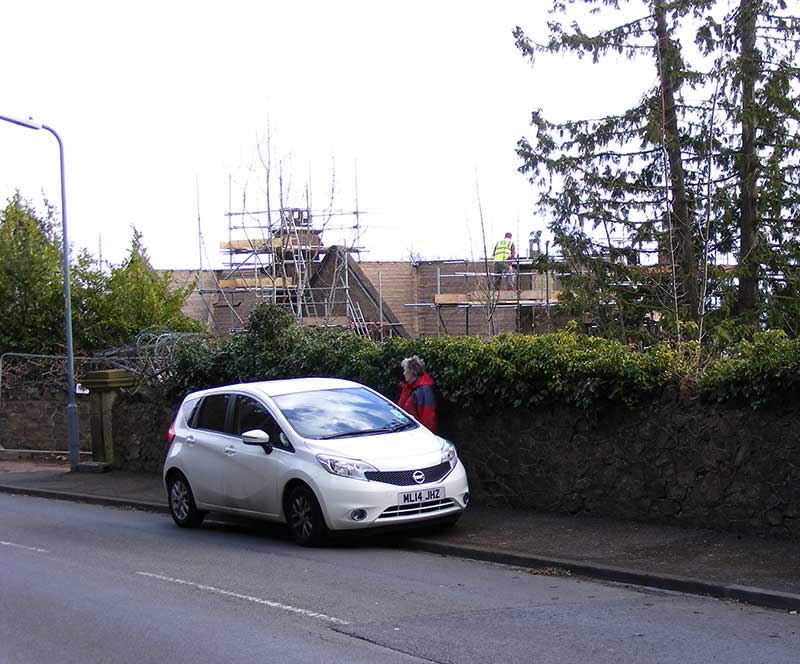
Work on the roof at Malvernbury
Littlebury's Directory of 1873 records that there was a
school for girls at Malvernbury run by a Miss Cooper. The house then became
a water cure
establishment.
Dr Edward Johnson (1801 - 1867), who had moved from
London, where his children were born, ran his water cure establishment first at
Ellerslie (see below) and later at Malvernbury, and his son Walter took over on his father's
death.
An 1887 edition of the BMJ, listing doctors registered in Worcestershire,
confirms a Dr W Johnson was at Malvernbury in Great Malvern.
Dr Walter Johnson married in 1867, South Tidworth
Hampshire, Mary Ann Sophia
Young the daughter of the Rector of Risley in Bedfordshire by whom he had
four children.
The 1881 census records the couple living at 'Bury' House
in Abbey Road which was almost certainly Malvernbury.
When Mary died in 1888, Walter Johnson retired to Kensington in London
to live near his younger brother Horace Edward Johnson MD.
Malvernbury was then acquired by Malvern College and used
as a boarding house for public school boys, from 1891 to 1906. Cambridge
educated Harry Wakelyn Smith was
the first housemaster succeeded in 1892 by sports master
Charles Toppin. In 1899 Edward Clifford Bullock (see below) was the housemaster. In
1903 Mr Bullock moved to Roslin House in College Road and Charles Theodore Salisbury became
the housemaster. Mr Salisbury moved to the larger Radnor House in 1906 which had been
acquired following the death of banker Christopher Dove Barker.
Edward Clifford Bullock, born Lincolnshire 1866, was the
son of a clergyman, educated Malvern College and Oriel Oxford. He became a
Captain in the 1st Worcestershire Volunteer Artillery; besides teaching he
was an officer with the Malvern College cadet force and served in France during the 1914-1918 war
achieving the rank of Lt Col. He was awarded the Territorial Decoration
(TD) for long service and in 1929 became a Deputy Lieutenant for the County
of Worcestershire. Latterly of Aylsford in Priory Road, Malvern, he died at Worcester
Royal Infirmary in 1954.
In 1907, Malvernbury, which was originally a tall five
storey property, was demolshed and rebuilt, probably for solicitor, William Dyson Perrins, grandson of
the founder of the Worcestershire Sauce business - in 1911 his wife Kate Perrins and son Meredith Dyson Perrins
were living there.
In recent times Malvernbury became a nursing home but
fell into neglect and was
purchased by a developer. The house has now been modernised and
converted into rented apartments (see photo below) and other dwellings may be built in the grounds.
A plaque placed by Malvern Civic Society recorded that Florence Nightingale
had been a visitor to the house between 1857 and 1860, but it was not
visible at the time of our visit so may have been removed during the
renovation work.
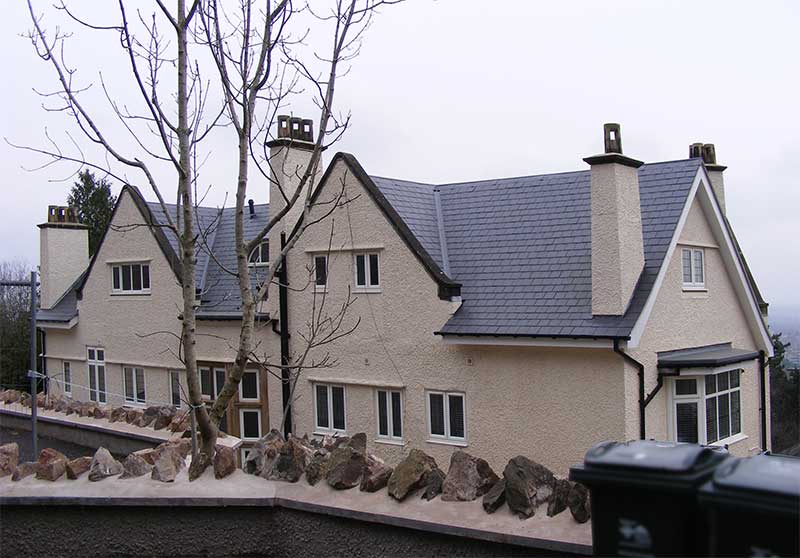
Malvernbury in 2017
Ashfield House
Next to Malvernbury on the corner of the junction of
Abbey Road and College Road stands a splendid mansion named Ashfield which is now owned by Malvern College (see
photo below).
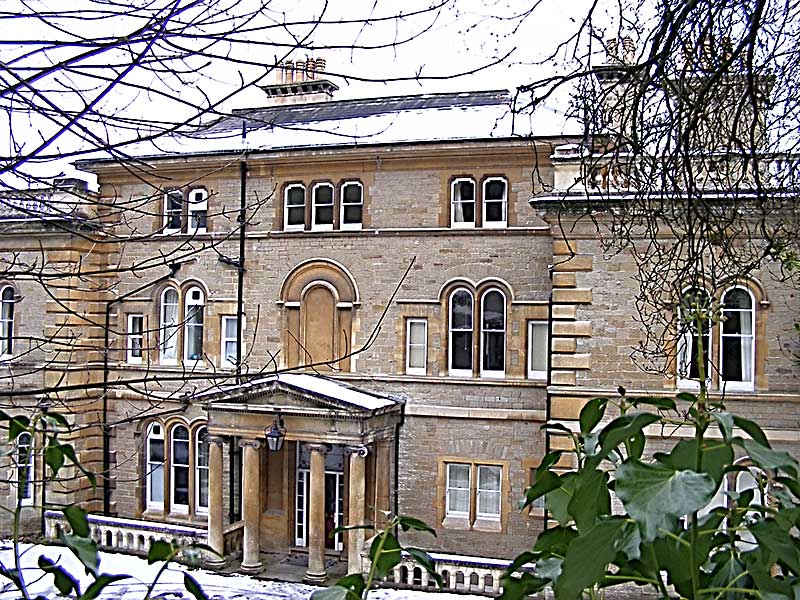
Ashfield House
In 1901 this was the home of Sir Augustus, Frederick
Godson, Barrister at Law, Freemason and one time MP for Kidderminster. His
daughter Ruth married a relation of the poet Alfred Lord Tennyson.
Kelly's Trade Directory lists a J C Smyth MD residing at
Ashfield in 1924.
Physician and Surgeon John Cecil Smyth, the son of
a solicitor, was born at Oldham in Lancashire in 1880 and died at Malvern in
1972.
J C Smyth was educated at Manchester Grammar School and
Owens College, where he was vice-chairman of the Union and later junior
demonstrator; he was house surgeon at Manchester Royal Infirmary and medical
superintendant to the Deptford Medical Mission, founded 1889, before
settling in Worcestershire.
He first married Robina Linklater Forsyth daughter of wine merchant
William Forsyth at Oldham in 1906 by whom he had three children; sadly she died at Ashfield on 8th June
1923 aged only 40 years.
Dr Smyth married second, in 1925, Dorothy Von Zabern,
daughter of a German shipping merchant, and the couple had a daughter Daphne
who married John Bamber the son of Rev John Reginald Bamber vicar of Crowle
1927 and later Holy Trinity church at Link Top. We were told after their
marriage Daphne and John went abroad to live in Uganda and later Kenya.
(J C Smyth's chauffeur, Arthur Edgecoombe Gillam had enlisted
in the Army Service Corps in 1915, at Worcester, and was a driver in the 181st
MT Company; sadly he died in France of double pneumonia on 4th November 1918, days
before the end of the war.)
Ashfield was aquired by Malvern College circa 1931 and
converted into flats for masters in 1953.
Ashfield Stables
From Abbey Road can be seen the clock tower of Ashfield
Stables by Douglas and Fordham of Chester, 1891, situated on the west side of Ashfield House (see photo below).
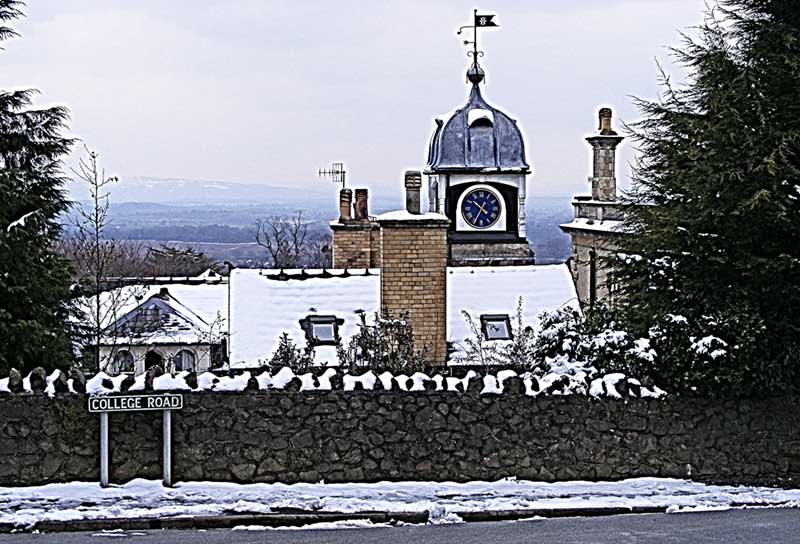
Ashfield Stables
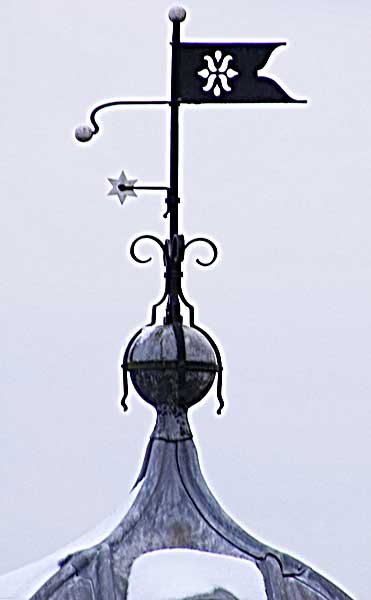
On top of the clock tower is a stylish 'arts and crafts' weather vane (see
photo opposite).
A lovely area in which to live, but beware of icy roads and
slippery pavements on sloping ground in the
winter.
Hampton House
Just below Ashfield, on the other side of College Road,
can be glimpsed Hampton House in the triangle of woodland between Abbey
Road, College road and the Wells Road; it stands in extensive grounds partly
obscured by shrubbery and trees and was possibly designed by
architect Edward
Elmslie.
The house was originally approached by a long drive from
the junction of Abbey Road with College Road.
Empty and boarded up in 2015, it has double bowed windows
overlooking the Severn plain (see photo below taken from College Road).
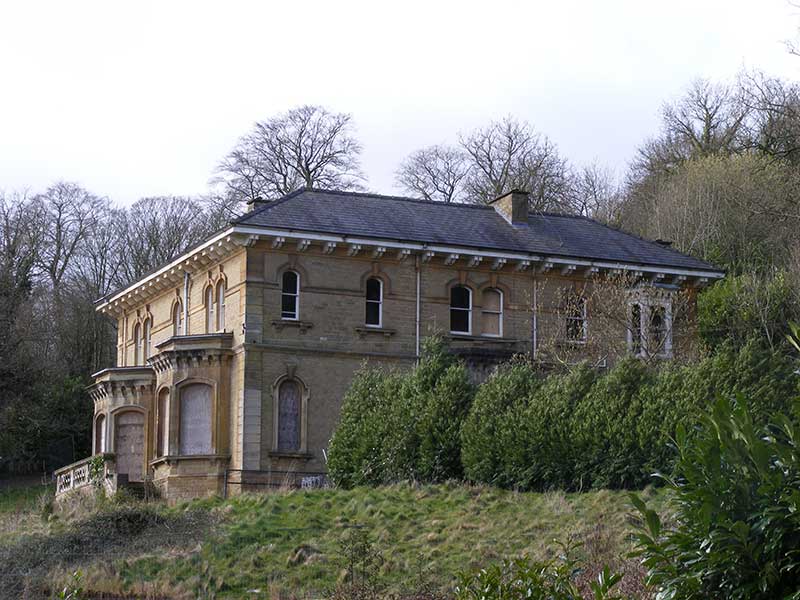
Hampton House in 2015
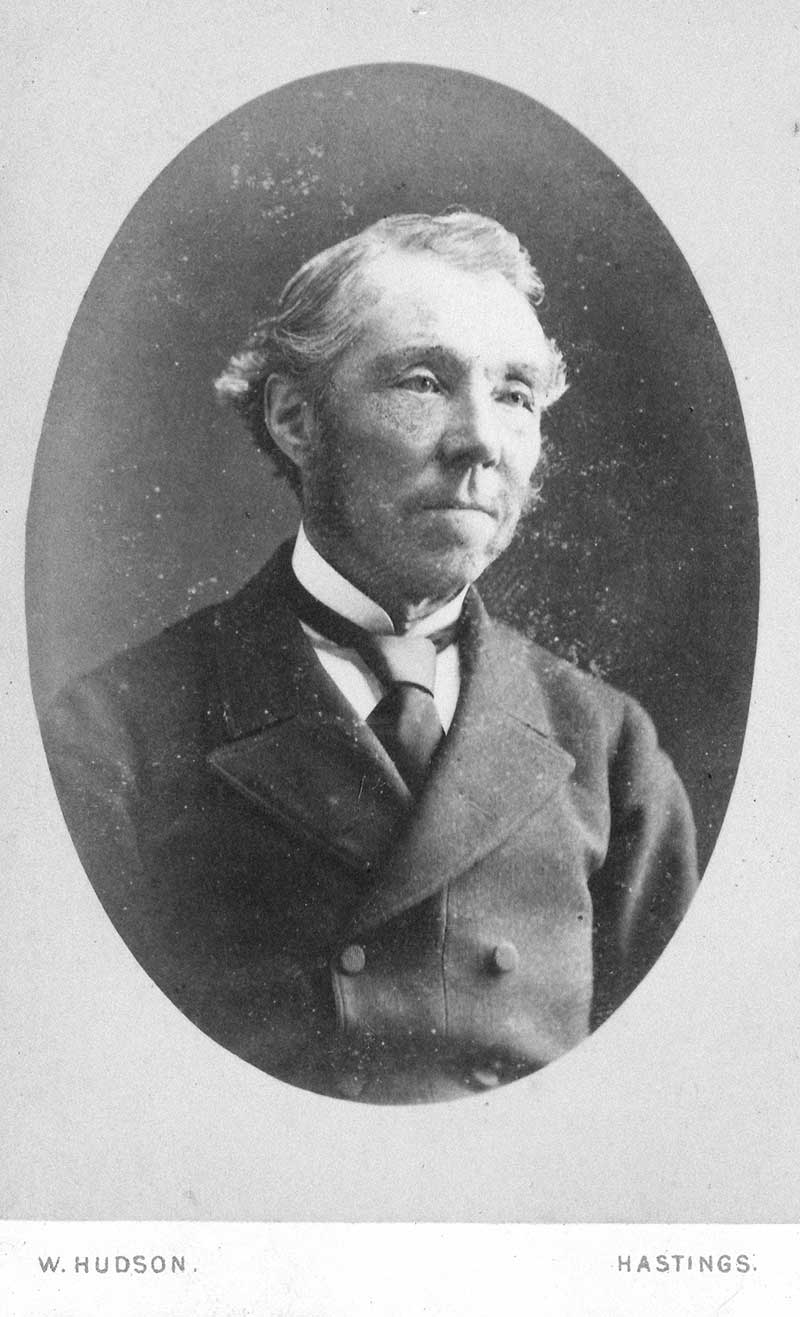 The 1891 census recorded retired manufacturer
James Atkins living at Hampton House with his second wife
Mary Ann Topham and four domestic servants. Living at Hampton House Stables
was their coachman with his wife and daughter. The 1891 census recorded retired manufacturer
James Atkins living at Hampton House with his second wife
Mary Ann Topham and four domestic servants. Living at Hampton House Stables
was their coachman with his wife and daughter.
The 1881 census had recorded James Atkins living in College Road, just
possibly at the same house, but by 1901 he had moved across the road to
Ellerslie, which was still his home when he died in 1904.
(James Atkins pictured left, courtesy of Ann Henderson)
More about James Atkins
James Atkins was born in Birmingham about 1819 the son of brass founder
Joseph Atkins. In 1842 he married Louisa Mason Williams the daughter of
tailor William Williams. They had two daughters Clara Louisa and Anne
Elizabeth and, in 1851 and 1861, the family lived in the Ladywood district
of Birmingham; the census then describes him as a commercial clerk. By 1871
there appears to have been an upturn in his circumstances when the census
decribed him as a merchant and manufacturer living in Hagley Road,
Edgbaston. A clue to his occupation appears in Whites 1873 directory of
Birmingham. To quote:
Atkins James
Gas fitting manufacturer
(RW Winfield and Co)
Thackeray House, Edgbaston
RW Winfield and Co of the Cambridge Street Works in Birmingham
employed several hundred men and boys and was founded in 1829; it manufactured metal bedsteads and the like. It seems James Atkins
was in charge of a new division which became one of the largest
manufacturers of gas fittings of its time. As far as we can gather James
Atkins became one of the partners running the company and rescued it from difficult
times. The London Gazette records that he resigned as a partner in 1879. The
other partners were
Rev Charles Busbridge Snepp, Philip Browne, Charles Walker Torr and
Henry Charles Taylor. Rev Busbridge Snepp died the next year; he had married
Julia Anne Winfield who was the daughter of RW Winfield who had founded the
company.
James Atkins may also have run a business named the Richmond Gas Stove
Company (ref 11).
Sadly this improvement in his business fortunes was marred by the death of
first wife; Louisa Mason Atkins does not appear in the 'Index of Deaths' but her
burial is recorded at
St Bartholomew's Church, Edgbaston on 27th November
1873 aged 56 years.
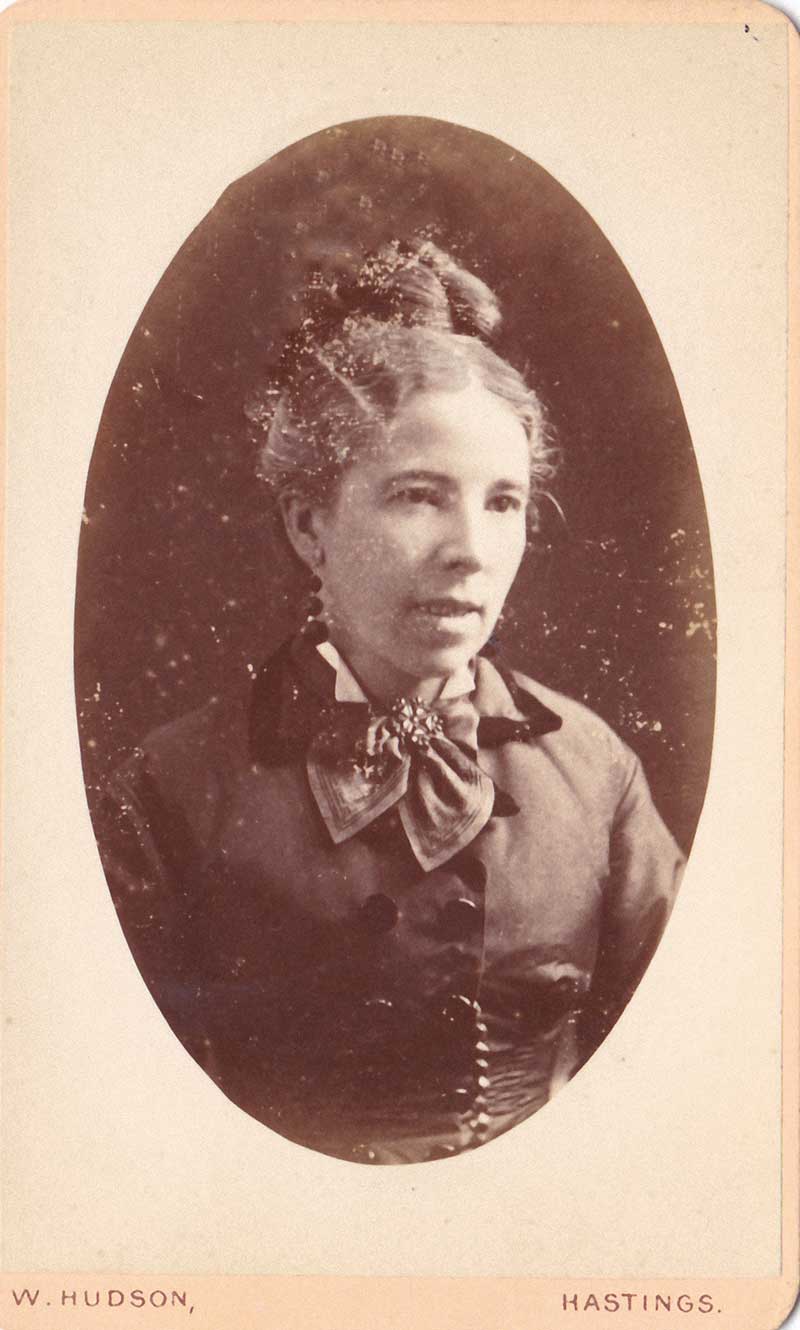 Three
years later, in 1876, James Atkins married, second, schoolmistress Mary Ann
Topham. See photo left, courtesy of Ann Henderson. Three
years later, in 1876, James Atkins married, second, schoolmistress Mary Ann
Topham. See photo left, courtesy of Ann Henderson.
Perhaps strangely, for residents of Birmingham, they were married at the
large church of St Martin in the Fields in London.
Mary was the daughter of a grocer who held a position on the Birmingham
City Council and it is possible she was introduced to James Atkins by her
brother William Topham who was a manufacturer of tin
plate and galvanized metal.
In 1872, at Liverpool, Mary Ann Topham's sister Elizabeth had married
Nehemiah Vinall who was an upholsterer and manufacturer of furnishings.
Their eldest son Joseph William Topham Vinall (1873 - 1953)
became a well known British Artist who had studied at the Royal College of Art.
He is listed in the Dictionary of British Artists (1880 - 1940) as are his
brother Nehemia Row Reeves and his daughter Ella Doreen.
The photograph below, dated 1930, shows JWT Vinall and his French born
wife Kate Chocqueel visiting Hampton House, which by this time had been
acquired by Ellerslie Girls' School. The reason for the visit is not
known; possibly they were just visiting an old family haunt, but they could
have come to deliver an art lecture to pupils of the school, or to photograph the
house prior to painting a picture.
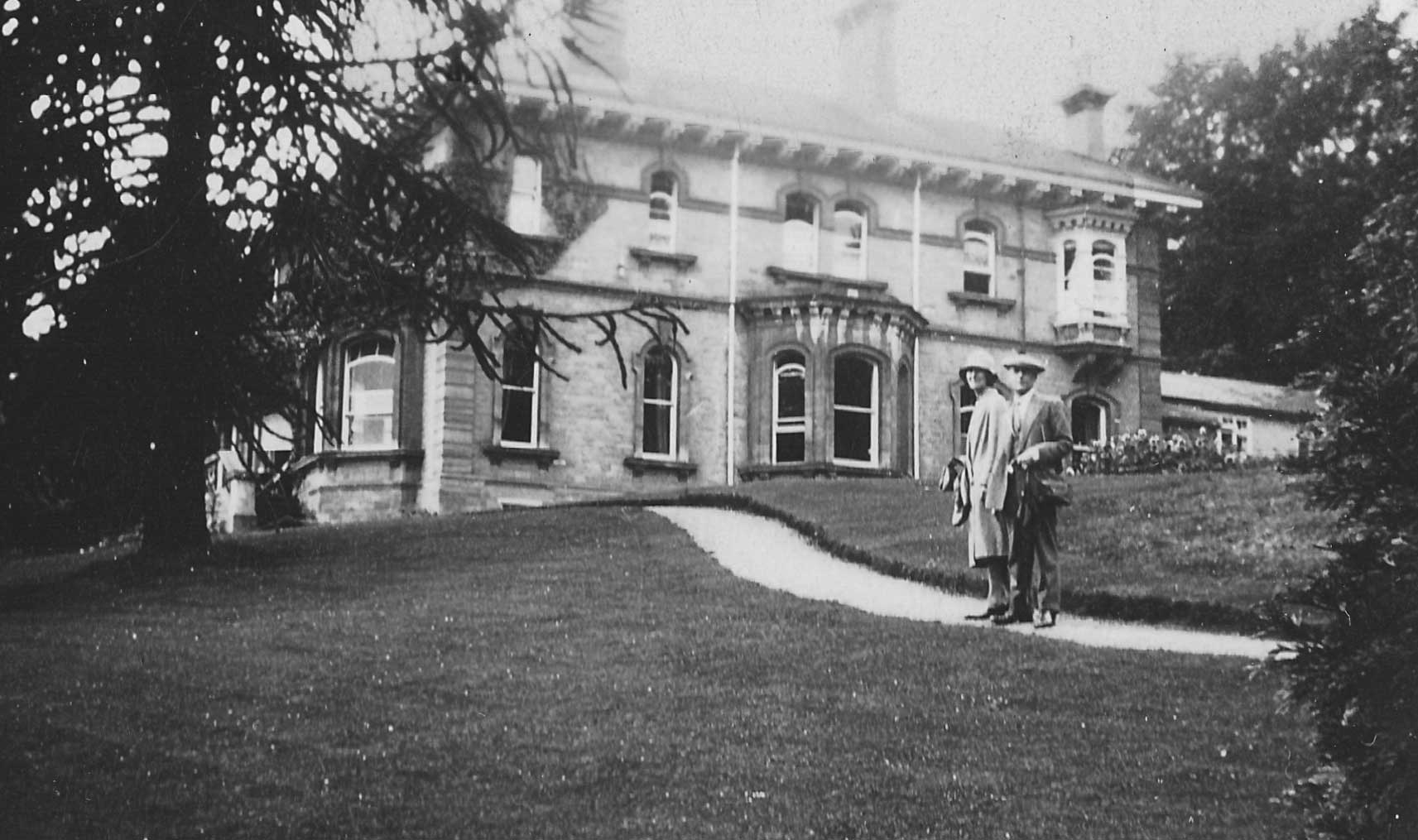
Hampton House in 1930, courtesy of Ann Henderson
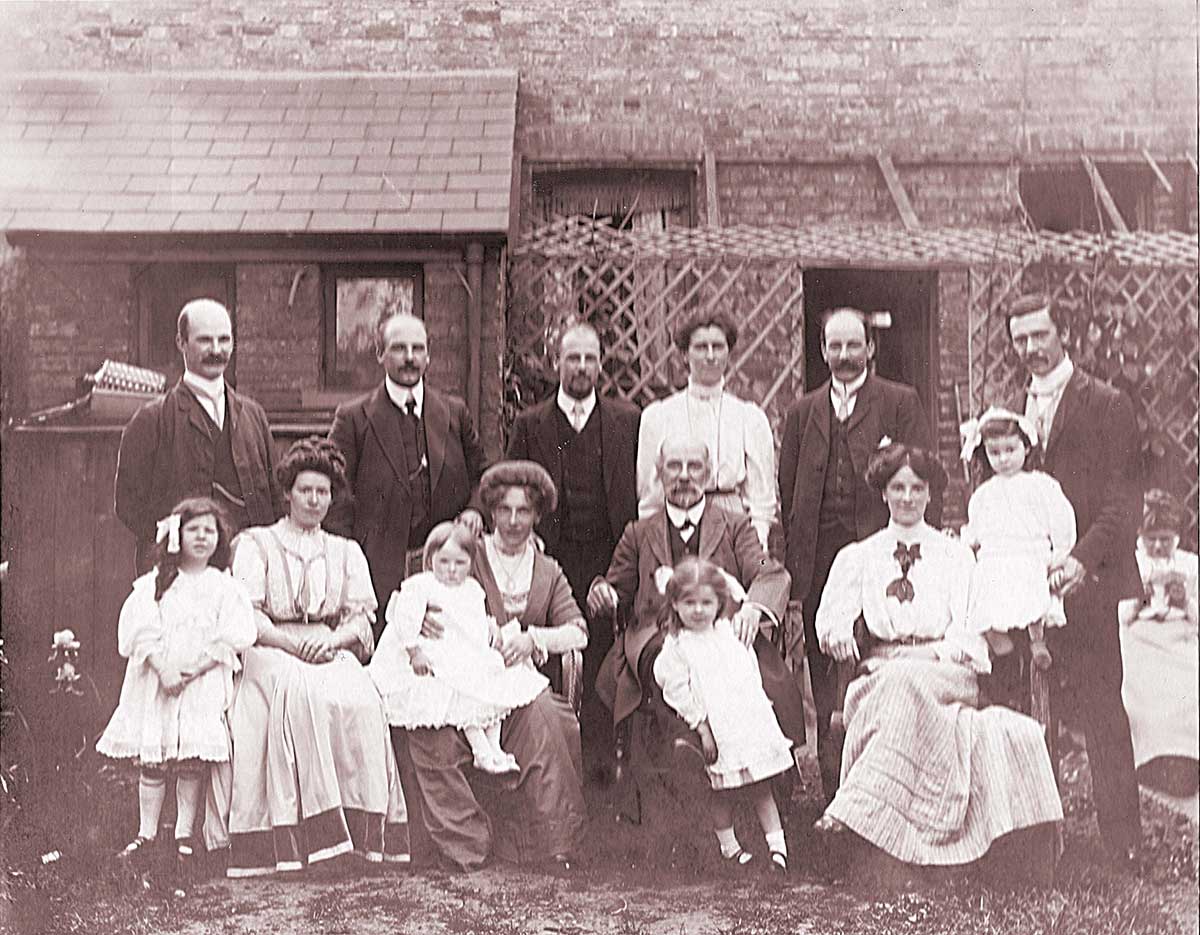
Artist JWT Vinall and his wife (centre rear row), courtesy Ann Henderson
Click to see example of a drawing
When James Atkins moved across the road to Ellerslie, Hampton House was
taken by Frederick Hookham.
Kelly's Trade Directory records Frederick Hookham still
living at Hampton House in 1924. He was born Oxford about 1846, and married
in 1876 Catherine
Ann Hyde, daughter of wealthy Wholesale-Clother Thomas
Hyde of
Caddecot House, Abingdon. (In 1945 Caddecot House became a Dr Barnardo's
home.)
In 1881 Frederick Hookham had been headmaster of
Kidderminster Grammer School; in 1901 he was a retired schoolmaster,
probably living on inherited wealth, at Hampton House where he died on 6th
November 1925. It was probably after his death that Hampton House was acquired by Ellerslie, a boarding
school for girls, on the other side of Abbey Road.
The photo below, kindly provided by a former Ellerslie pupil, shows the front of Hampton House as it was in 1965, when
it was owned by Ellerslie school.
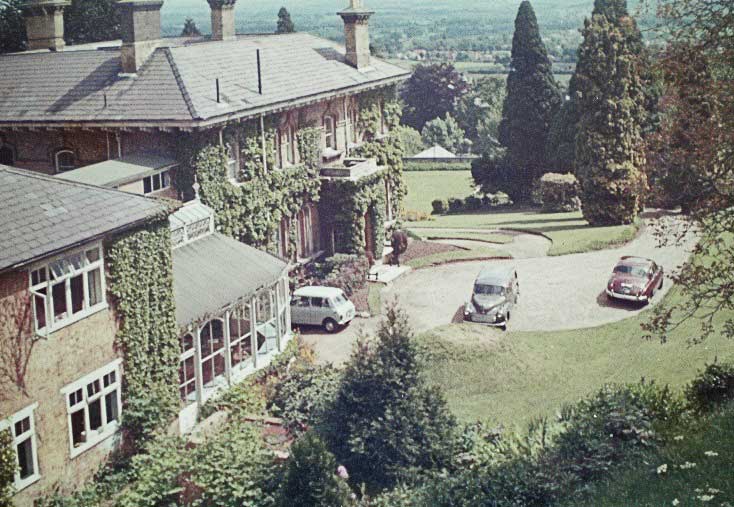
Hampton House in 1965
In recent times Ellerslie School was acquired by Malvern
College and subsequently Hampton House, and its grounds, extending to more
than two acres, became surplus to requirements and was sold to a developer. 'Margaret Prior Hall' by Goodwin and Cowper,
which had been
built as a sports hall in the grounds of Hampton House for Malvern College,
when the house was being used as a reception department of Hillstone School,
was demolished circa 2014. After clearance of the site, the land was again
offered for sale in 2015.
In 2017 we revisited the corner of Abbey Road and
College Road to view the progress of building work on the site.
Hampton House is now approached
by a new drive off College Road. The house has been renovated and divided
into apartments and the roof extended to incorporate penthouse flats, whilst
other redbrick homes are being built in the grounds.
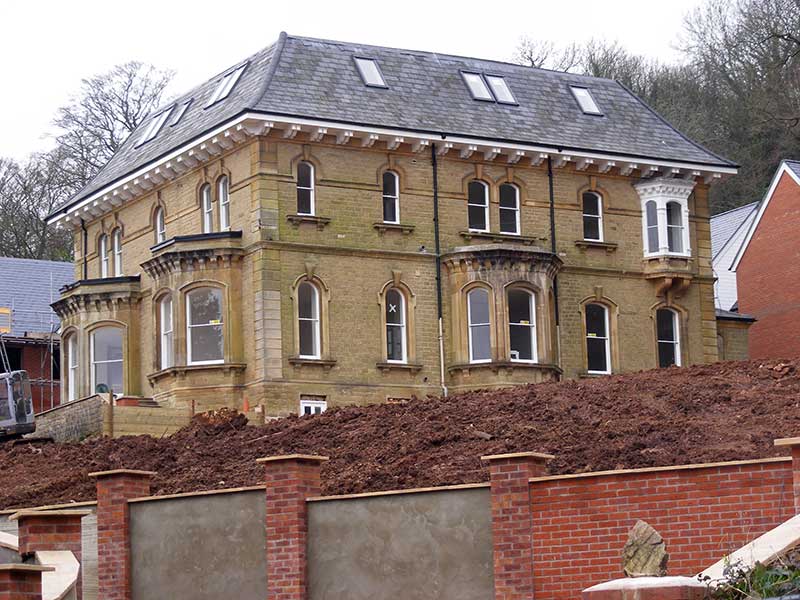
Hampton House in 2017
In phase 2 of the development more homes will be built in
the woods to the north of the house.
Ellerslie
On the opposite side of Abbey Road about 100 yards past
the junction with College Road
stands another large house named Ellerslie, built circa 1855.
We took the photo below in 2012 when the site was empty, and protected by
security fencing, awaiting development.
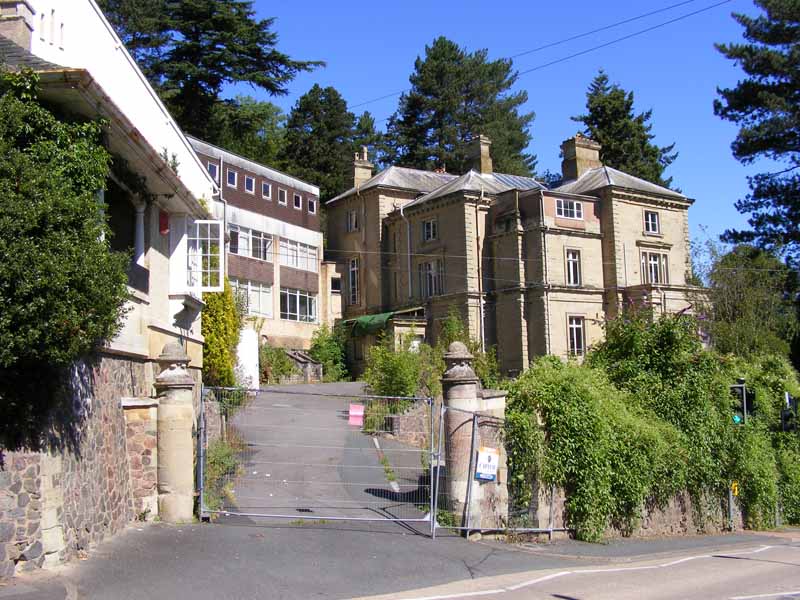
Ellerslie in 2012
In the 20th century Ellerslie became a girls' school and
classrooms were added on the south side, and a hall which doubled as a
chapel on the north side. You can read more about
Ellerslie Girls' School on our page about
Malvern schools
then and now.
The Water Cure
In earlier times Ellerslie had been a
water cure establishment.
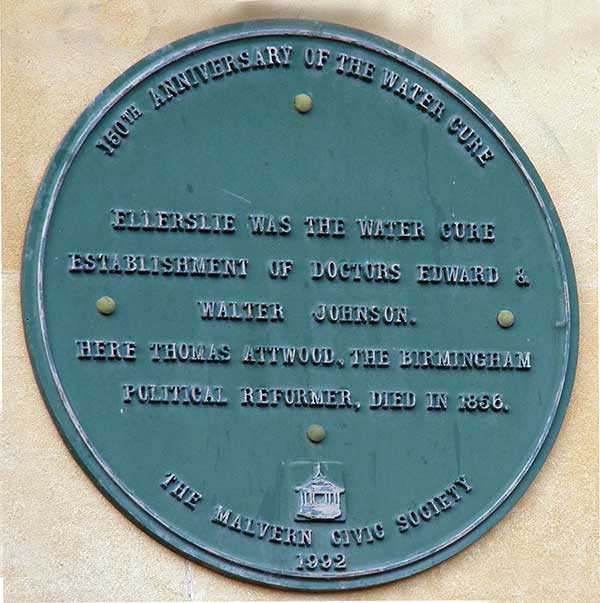 A plaque
emplaced by Malvern Civic Society on the wall of the lodge beside the gate
at Ellerslie reads: A plaque
emplaced by Malvern Civic Society on the wall of the lodge beside the gate
at Ellerslie reads:
150th Anniversary of the Water Cure
Ellerslie was the water cure establishment of Doctors
Edward & Walter Johnson.
Here Thomas Attwood the Birmingham political reformer died in 1856.
The Malvern Civic Society 1992
Dr Walter Johnson was Edward's son.
Thomas
Attwood 1783 - 1856 was the first Member of Parliament for Birmingham.
Although he was an old and infirm man, his death was probably not a good advertisement for the
water cure!
By 1862 Dr Johnson and his son had moved their water cure
practice across
the road to Bury House later known as Malvernbury.
William Eastwood, a lodging house keeper, was recorded at
Ellerslie in Slaters Directories of 1861 and 1862.
Freemasonry
By 1871 Ellerslie had become the home of Albert Hudson Royds, Magistrate,
Landowner and Freemason, born Rochdale 1811 son of woollen merchant Clement
Royds, High Sheriff of Lancashire.
-
It is of note that Albert Hudson Royds also had a
connection with the Masonic Hall which was once based in College Road. A group of Freemasons of the Worcester Lodge met in 1867
and decided to found a Lodge in Malvern. It was named The Royds Lodge after
the Provincial Grand Master of Worcestershire at the time, Albert Hudson
Royds. It was consecrated at Townshend House, in College
Road. Townshend House, built about 1850, was then the
home of water cure doctor, Ralph
Barnes Grindrod (1811 - 1883).
-
In 1879 the Freemasons leased Hardwicke Bath House in
College Road, which lay below the old water cure establishment of
Hardwicke House in Abbey Road, By the 1900s this venue was considered
unsuitable and the Freemasons moved to Belle Vue Terrace. The old
Masonic Hall is now a private residence with tall chimneys named Royd's Lodge.
In 1901 Ellerslie was occupied by James Atkins aged 81
years, a retired manufacturer, who had moved across the road from Hampton
House.
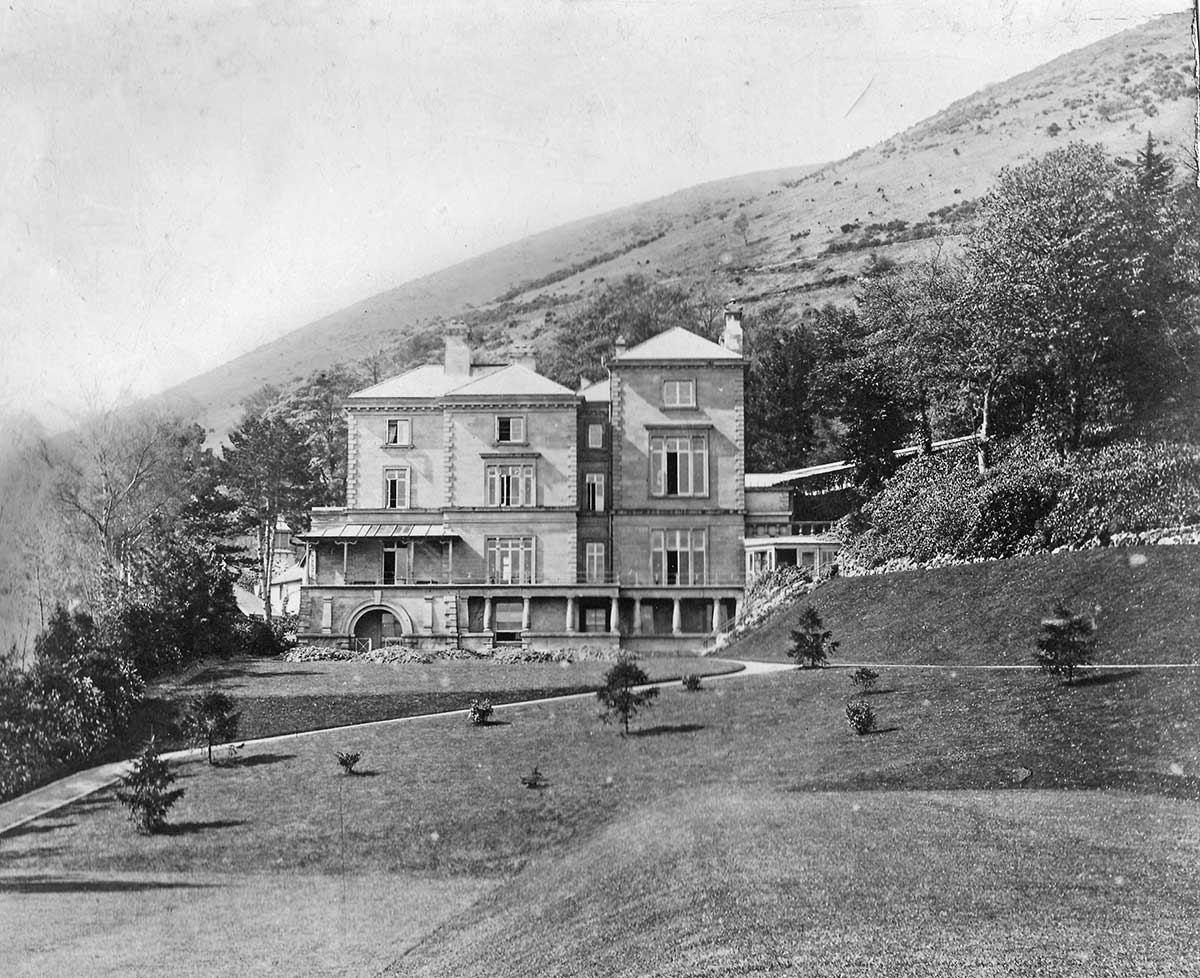
Ellerslie circa 1909, courtesy of Ann Henderson
James Atkins died in 1904 and his two
spinster daughters, then living in Leamington, were appointed his executors.
When they died in 1922, they appear to have left the family
fortune to an elderly friend, the Glasgow born artist Alexander Lawson
(1861 - 1927) who had visited them at Fairfield, Goring on Thames, in 1911.
Perhaps he had come to paint
Goring
Lock which adjoins the picturesque river crossing at Streatley.
Click for
photo of Goring Lock
The Artist Alexander Lawson is not well known but has a short entry in the Dictionary of
Victorian Painters. To quote:
Alexander Lawson flourished 1890 to 1903
Wolverhampton landscape painter. Exhibited mainly at the
RA. Titles include views in Wales, Staffordshire, Scotland and coastal scenes.
The son of a picture framer, he married in 1889 pianist
Florence Amelia Thistlewood, the daughter of a Birmingham based musician, by
whom he had two sons. At the time of his death Alexander and his wife were living at Chandos, Burdon Lane, Cheam
in Surrey.
James' widow Mary Ann Atkins left Malvern and retired to
Sunny Mount in Bexhill-on-Sea, Sussex, where she died in 1911. One of her
executor's was her niece Ada Louisa Sutton, the daughter of her half sister
Ann Topham, who had married innkeeper William Sutton. Bexhill appears to
have been a favourite place for residents of Great Malvern to retire to.
In 1911 Ellerslie was occupied by widow Julia Caroline
Colt nee Hutton.
Her coachman Adam Anderson lived at Ellerslie Cottage,
and gardener Robert Scott
lived at Ellerslie Lodge.
Julia Colt's wealthy husband Captain George
Frederick Russell Colt died at Great Malvern in 1909. In 1881 his
occupation had been recorded as proprietor of the Gartsherrie Estate,
Roxburgh, Scotland.
We found this biography about him:
George Frederick Russell Colt of Gartsherrie House,
Coatbridge, Lanarkshire, was born 14 January 1837 at Gattonside, Melrose,
the son of John Hamilton Colt Esq and Jane, daughter of George Cole
Bainbridge. He married on 28th Jun 1865 Julia Caroline Hutton with whom he
had one son. He was a Justice of the Peace and succeeded to his fatherís
estate at Gartsherrie in 1862. He wrote a family history (with the long title))
'History & genealogy of the Colts of that ilk and Gartsherrie, and of the
English and American branches of that family' which was printed for private
circulation by Turnbull and Spears of Edinburgh in 1887.
We wondered what had brought the couple to Great Malvern?
Widow Julia Caroline Colt formerly of Ellerslie, Malvern,
died on 10th May 1920 at Edinburgh.
During WWI Ellerslie was occupied by 'North Forelands
School' which had been evacuated from Kent. When that school returned to
Kent, Miss Gladys Mabel Pearson Sayle started
Ellerslie School circa
1924.
North Grove
On the other side of the road from Ellerslie, just below
the junction of Abbey Road with the Wells Road is a pair of large linked
residences named North Grove and South Grove. In the photo below North
Grove, now numbered 67, is to the left of the picture.
The houses, now divided into apartments, overlook Hampton
House below and the Severn plain.
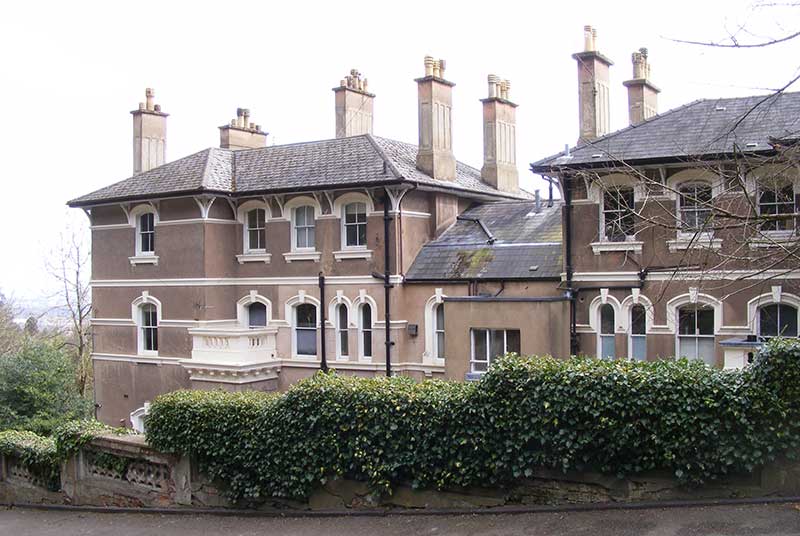
North Grove and South Grove, at the top of Abbey Road
We don't know exactly when North Grove was built, but
Slaters Directory records a William Holden in residence in 1862. In 1870
William Matthews, a magistrate and ironmaster, born Hagley
about 1797 was in residence. In 1873 a Richard Watson was the occupier; we don't know
anything about him, but possibly he was a retired Worsted Spinner.
In 1901 North Grove was occupied by Scottish born widow
Sophia Kate Smith, (1854 - 1938) aged 46 years, her mother Christiana Mackie
(1829 - 1913), and her
daughter Alexandra Sophia Isabella Smith (1884 - 1941); plus servants.
Sophia's first husband Alexander Smith was described as a master mariner on their
daughters marriage certificate. In the 1891 Scotland census he is described as living
on private means in Forres Morayshire, while she is visiting her sister
Christiana Ferguson in Govan. Later in 1901, Sophia married, second, Ellis
William Davies a civil servant, senior clerk of the exchequer and audit department
in London.
The 1911 census records Ada Mary Gillott Weiss aged 49
years as head of house, the daughter of wealthy Swiss general merchant Henry
Weiss, living with her two sisters, a parlour maid, housemaid, cook, and
under-housemaid.
South Grove
Next door at number 69, South Grove, in 1901 and 1911 was
living widower
Donald MacDonald a retired Colonel of the Indian Army who was
born in Calcutta, living with a sister and three servants.
Earlier, in 1862, Mrs Martha Storry had been in residence at
South Grove, where she died in 1872. In 1861 Martha had been at The Elms.
She was the widow of clergyman John Bridges Storry who was born
Colchester about 1790 and had been Vicar of
Great Tey in Essex. Martha was
the daughter of Rev Dr Romaine of Castle Hill Lodge, Reading.
Next a Miss Glover was in residence at South Grove, and
in 1892 Rev Henry Lea Guillebaud, a retired clergyman. He was born Nailsea
Somerset about 1815, the son of Peter Guillebaud, Rector of Nailsea. Henry
had been Vicar of
Thurgarton
in Nottingham but later, in 1881, he was living at 27
Warrior Street, Hastings. Henry had several children by his wife, Jemima
Allnutt.
Very sadly Henry's grandson Lt Geoffrey Pierre
Guillebaud, D Company, 6th (service) Battalion,
The Loyal North Lancashire Regiment, was killed
at the Battle of
Chunuk Bair on 10th August 1915 fighting the Turks. He was
aged only 20 years. The 6th Battalion had landed at
Anzac Cove, Gallipoli
only a few days previously. The CWGC records Geoffrey was the son of the Rev J A
Guillebaud, and of Sarah Helena Guillebaud (formerly Peters) of Yatesbury,
Calne, Wiltshire. Educated at Marlborough College. Scholar of Queen's College,
Oxford; his name appears on the Roll of the Fallen at All Saints, Yatesbury.
We wondered if Henry's family was related to the Peter
Guillebaud who had been a
Huguenot Silk
Manufacturer of Stewart Street, Spitalfields.
North Grove and South Grove are recorded in the 1911 census as having 15 and
14 rooms respectively - including the kitchen, but not counting scullery
landing, lobby, closet or bathroom. Nowadays that might be considered
excessive for the relatively small households mentioned above!
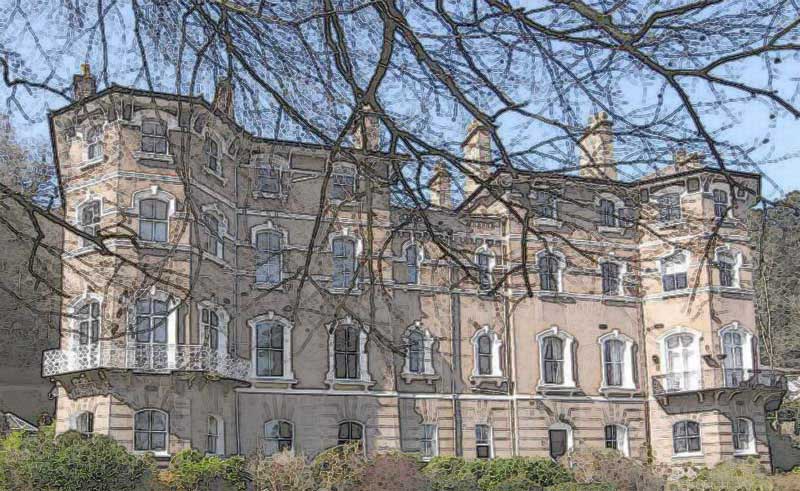
North Grove and South Grove can be glimpsed through the trees from College
Road (see illustration of eastern side above). They are a pair of linked residences of four
floors, with bow windows at each side, which must provide magnificent views.
On reaching the southern end of Abbey Road we turned
right into the Wells (Worcester) Road to return to Great Malvern Post Office
- take care on the corner and consider hanging onto the railings as the turn
of the footpath is steep.
Click to continue to next page
Notes
In 1992 Ellerslie Girls' School was acquired by
Malvern College and about 2008 the pupils moved down the hill to College
Road. The
valuable parcel of land which included Ellerslie, Cherbourg House and Southlands, on the Wells
Road, was sold for development. When the photograph of Ellerslie was taken
in 2012 the buildings were empty, and protected by a security fence,
awaiting planning permission. After some delay, including work to preserve the bat
population, 'Audley'
commenced work on a vast Retirement Village on the Ellerslie site in January
2015, marking the beginning of a new era for Victorian Abbey Road.
There have been some other changes in Abbey Road,
since this page was first published. A new memorial to water cure Doctor
James Wilson has been erected at the junction with Priory Road; Hampton
House across the road from Ellerslie has been modernised and new homes are
being built in the grounds; finally Malvernbury, opposite Ellerslie, has
been renovated and is now visible after removal of hedges.
References
- Census of England and Wales 1851 - 1911
-
Malvern
and its famous visitors, Malvern Civic Society, printed by Aspect Design
- Weaver Cora and Osborne Bruce, Aqua Malvernensis, a history and
topography of the springs, spouts, fountains and wells of the Malverns, and
the development of the public water supply, printed by Aldine Press, 1994..
- Hall-Jones Roger, The Story of Park View Malvern, published and
printed by First Paige, Abbey Road, Malvern, 1998.
- Maps of Great Malvern 1884 and 1934, Malvern Library
- Moody Catherine, Silhouette of Malvern from Queen Victoria to Queen
Elizabeth II, The Priory Press, Malvern, 1953.
- Brooks Alan and Pevsner Nikolaus, The Buildings of England,
Worcestershire, Yale University Press, 2007.
- Map of Foley Estate 1828.
- Grierson Janet, Dr Wilson and his Malvern Hydro, published by Malvern
Museum 1998.
- Conolly Pauline, The Water Doctor's Daughters, Robert Hale, 2013.
- Communication from Ann Henderson, March, 2017
- National Probate Calendar
- Communication from David Green, August 2017
- Communication from Geoff Lewis, September 2017
- Communication from F Renger, Malvern Museum, February 2018
- Stevens annual Directories, 1900 to 1925
Back to top
Please email suggestions for corrections or additions to this page to
the webmaster
|


 Malvern Museum
Malvern Museum

 A
blue plaque on the right of the entrance reads:
A
blue plaque on the right of the entrance reads:


 The garages below The Gate House mentioned above occupied
the site of Warwick Livery Stables.
The garages below The Gate House mentioned above occupied
the site of Warwick Livery Stables.


 The
Baptist Church was built about 1893 on the site of the Hay Well Baths, one of Dr
Gully's Hydropathic Establishments. The Baptist minister at the time was Rev
William James Povey MA who acquired the land in 1889 and retired from the
church in 1919; you will find his grave in Great Malvern cemetery.
The
Baptist Church was built about 1893 on the site of the Hay Well Baths, one of Dr
Gully's Hydropathic Establishments. The Baptist minister at the time was Rev
William James Povey MA who acquired the land in 1889 and retired from the
church in 1919; you will find his grave in Great Malvern cemetery. Across the road is number 33, an
imposing block of apartments overlooking Priory Park, now known as
'Park View'. The building was completed about 1848. Park View was
originally built as a Hydropathic Water Cure Establishment (see plaque opposite) for Dr James Wilson (born
1807 Holywell, Flintshire, died 1867 Ilkley, Yorkshire). When the 'Water Cure' waned
the Hydro became the County Hotel, and later it was used as a hostel for Royal Radar
Establishment apprentices. The photo below was taken from Priory Park and
shows the fine bowed facade.
Across the road is number 33, an
imposing block of apartments overlooking Priory Park, now known as
'Park View'. The building was completed about 1848. Park View was
originally built as a Hydropathic Water Cure Establishment (see plaque opposite) for Dr James Wilson (born
1807 Holywell, Flintshire, died 1867 Ilkley, Yorkshire). When the 'Water Cure' waned
the Hydro became the County Hotel, and later it was used as a hostel for Royal Radar
Establishment apprentices. The photo below was taken from Priory Park and
shows the fine bowed facade.
 There
is a second plaque alongside the entrance to Park View. This reads,
There
is a second plaque alongside the entrance to Park View. This reads,








 The
plaque on the north side of the memorial reads:
The
plaque on the north side of the memorial reads:





 You
can't see much of Chesfield from Abbey Road. This long distance shot of the
east face of Chesfield was taken from Guarlford (see photo opposite).
You
can't see much of Chesfield from Abbey Road. This long distance shot of the
east face of Chesfield was taken from Guarlford (see photo opposite).





 The 1891 census recorded retired manufacturer
James Atkins living at Hampton House with his second wife
Mary Ann Topham and four domestic servants. Living at Hampton House Stables
was their coachman with his wife and daughter.
The 1891 census recorded retired manufacturer
James Atkins living at Hampton House with his second wife
Mary Ann Topham and four domestic servants. Living at Hampton House Stables
was their coachman with his wife and daughter. Three
years later, in 1876, James Atkins married, second, schoolmistress Mary Ann
Topham. See photo left, courtesy of Ann Henderson.
Three
years later, in 1876, James Atkins married, second, schoolmistress Mary Ann
Topham. See photo left, courtesy of Ann Henderson.




 A
A 


